Россия, Украина и мир-VI: аспекты императивной девестернизации российского образования
Discussion with an astute Russian reader
Обсуждение с проницательным русским читателем
Contents
I. Introduction
II. How Western Europeans westernized Russians for 300 years
III. Unreliable Wikipedia
IV. Reading texts & reading in-between the lines of texts
V. Rejection of the fallacy of Hellenism: starting point of every effort of De-Westernization
VI. Why Shakespeare and the Western European Theater must be removed from the Russian, Chinese, Indian, African, Muslim and Latin American Education
VII. Shakespeare’s black magic trickery against the concept of Messiah, and his vicious hatred of Eschatology and Revelation

Содержание
I. Введение
II. Как западноевропейцы вестернизировали русских за 300 лет
III. Ненадежная Википедия
IV. Чтение текстов и чтение между строк текста
V. Опровержение заблуждения эллинизма: отправная точка всех усилий по девестернизации
VI. Почему Шекспира и западноевропейский театр надо убрать из русского, китайского, индийского, африканского, мусульманского и латиноамериканского образования
VII. Шекспир и его черная магия против концепции Мессии и его яростная ненависть к эсхатологии и Откровению
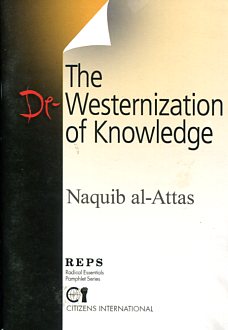
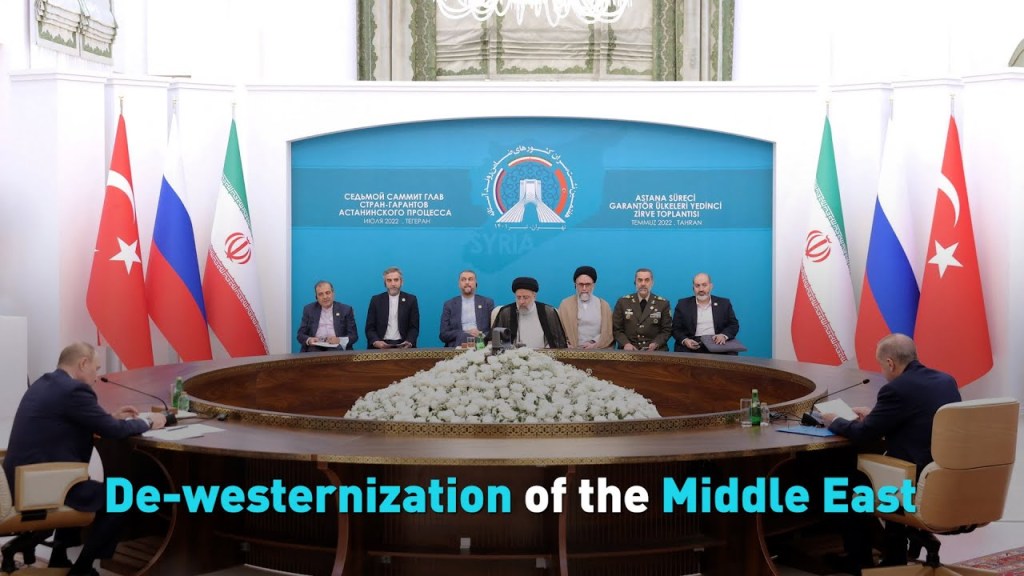
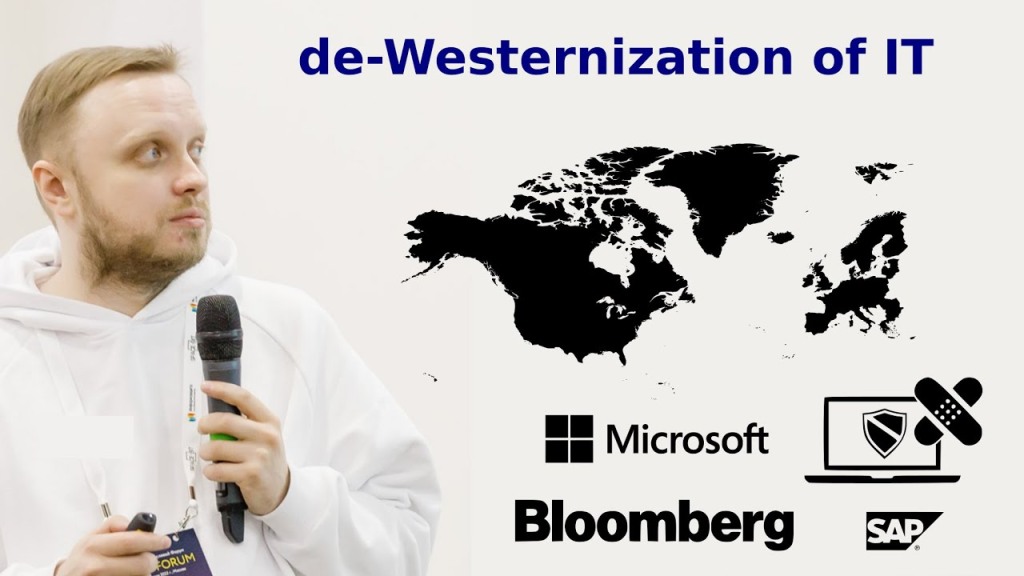

My articles about the Russia – Ukraine conflict generated vivid reactions from many readers and several among them wrote to me in order to ask about several topics or comment on my approach and description. A long correspondence ensued, and at times it helped me better feel how readers perceive different issues and understand my criticism of several practices or developments.
I. Introduction
Numerous recent speeches given or articles and books published by leading statesmen like Xi Jinping, Subrahmanyam Jaishankar, Vladimir Putin, Wang Yi, Dmitri Medvedev, Narendra Modi, and many others underscore the need to establish a new, multipolar world order and thus take mankind to the next stage of comprehensive, multilateral development and progress. An important part of this discourse is dedicated to the need of de-Westernization or de-Occidentalization. The topic is being now discussed in the foremost venues of the BRICS member states and in other international bodies. I herewith mention as examples the Valdai Discussion Club (est. 2004) and the Valdai Club Foundation (est. 2011), which manages the Club’s projects.
In his article “A New Era of De-Westernization Has Begun” (6 January 2023), Valdai Club expert Wang Wen made it clear that “the political equivalence structure between the West and the non-West is increasingly strengthened and is becoming an important feature of world politics in the third decade of the 21st century. Of course, the world in 2023 will not be mellow, but in any case, amid the “de-Westernization”, major changes unseen in a century will continue to evolve in an irreversible way, writes”. https://valdaiclub.com/a/highlights/a-new-era-of-de-westernization/
Although the need for de-Westernization is evident and highly acclaimed across Asia, Africa, Latin and -notably- Eastern Europe, it is not quite sure that all people mean the same connotation when using this term. I don’t suggest that there are opposite approaches to this issue, but many people still fail to fathom the depth and the width of the de-Westernization that is needed for nations across the Earth to finally achieve national identity, cultural integrity, political independence, and economic self-determination. Many people limit unconsciously their approach and efforts within politics; but there a major danger is lurking.
Does it really matter whether all the countries of Asia, Africa, Latin America, and Eastern Europe are politically, militarily, economically and financially independent from the block of the Western European and North American states that colonized (and, in the process, Westernized) almost all the other nations of the world?
I would even ask the following:
Does it really matter whether all the countries of Western Europe and North America collapse and disappear from the surface of the Earth?
With the former colonizers dissolved and with Asia, Africa, Latin America, and Eastern Europe politically, militarily, economically and financially de-Westernized, still all these countries will indeed be inhabited by mere ‘copies’ of Western citizens and Westernized automatons or homunculi, if the de-Westernization effort fails to be as deep and as wide needed at the levels of academic and intellectual life, scientific research, education, socio-behavioral system, culture, mentality, and even religion and spirituality. This is so, because a Muslim incorporated into or accommodated within the Western system of values, principles, concepts and worldview will de facto function as a non-Muslim either he fasts, prays and has no extramarital relations.
——————————————————————-
What is De-Occidentalization for Russia, Asia, Africa and Latin America?

In your school, you learn about the Kurukshetra battle (Mahabharata) – and not about the insignificant battle of Thermopylae

In your school, you learn about Gan Bao’s Soushen Ji (here in a Ming copy ca. 1550), which is a compendium of legends and narratives concerning the spiritual universe that was first written around the middle of the 4th c. CE – and not about Seneca’s Hercules furens (Mad Hercules)
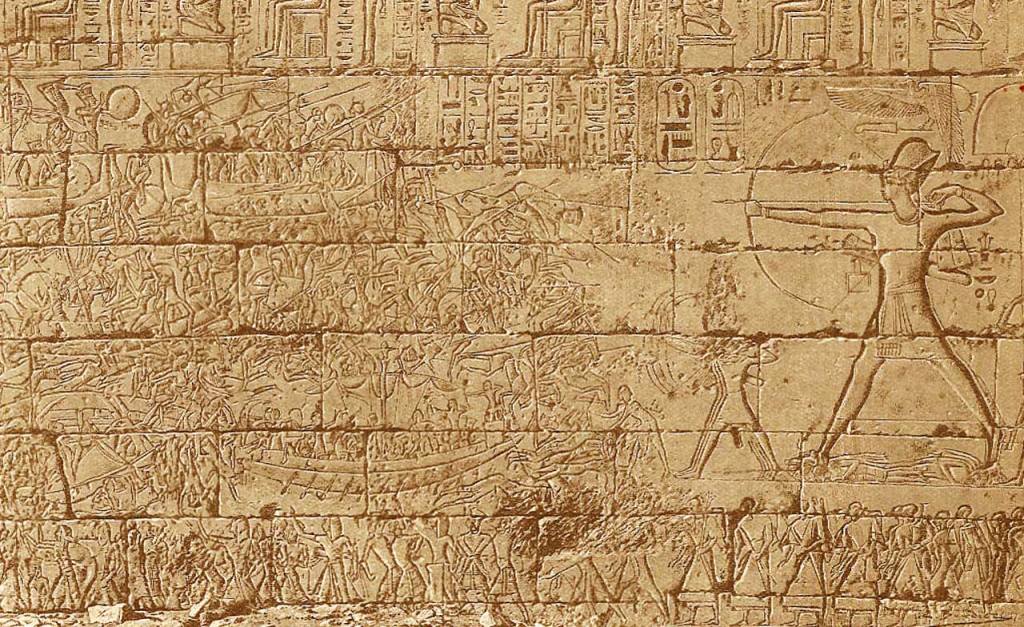
In your school, you learn about the Annals of Ramses III and the narratives about his victories over the Sea Peoples that determined the World History – and not about the absurd lies that the Carian (non-Greek) traveler Herodotus wrote about the unimportant wars between a few Ancient Greek states and the invading armies of the Iranian Emperor Darius
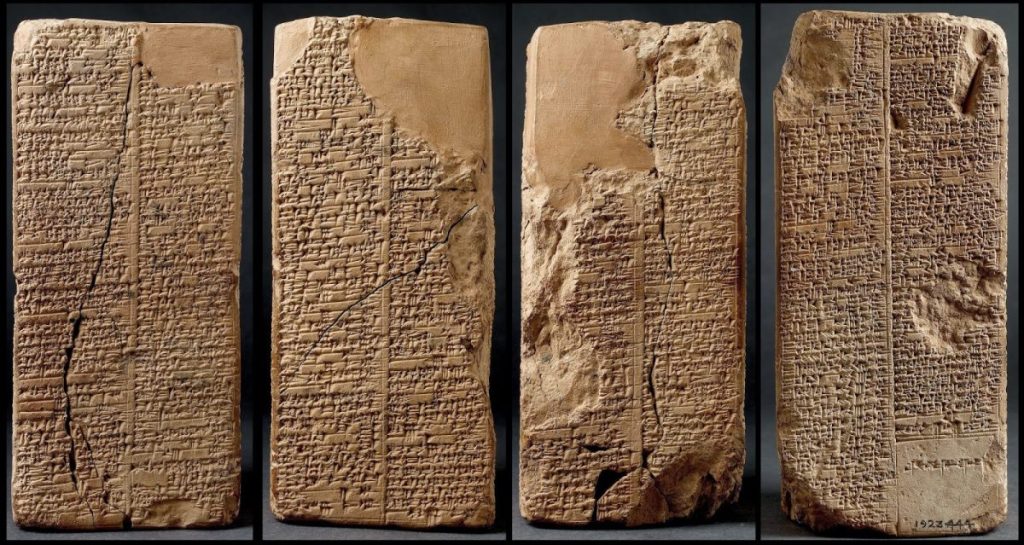
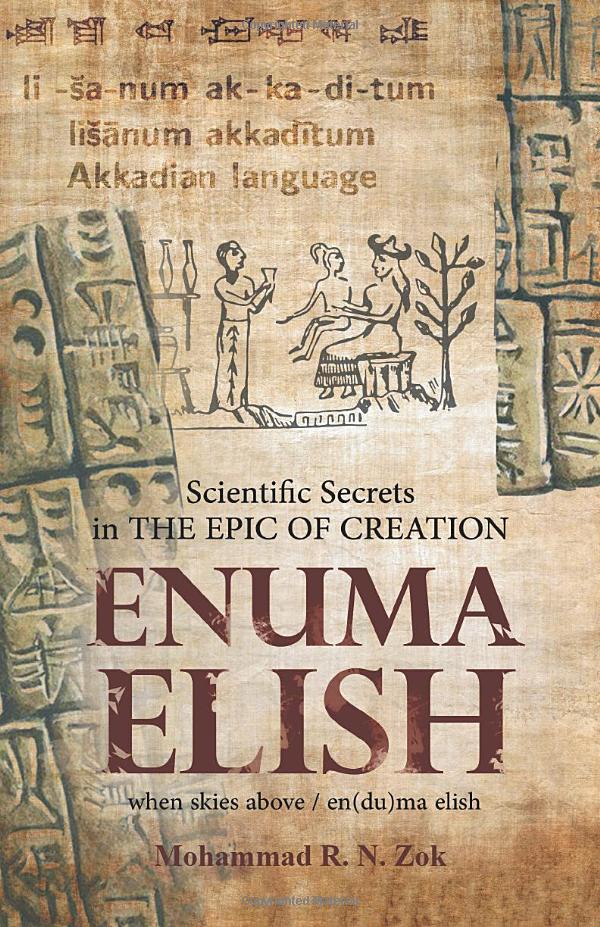
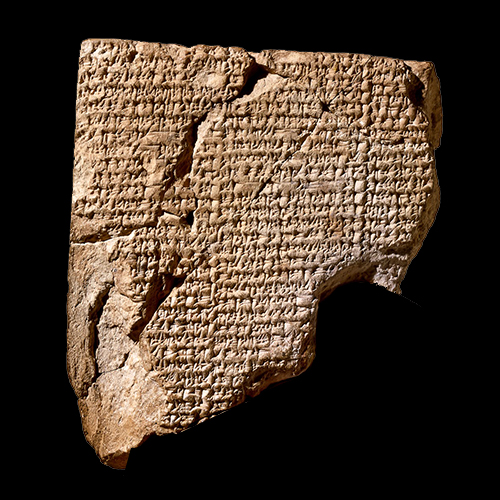
In your school, you learn about Enuma Elish, the Assyrian-Babylonian Epic of Creation (four tablets in cuneiform in the upper picture), and Atrahasis (also known as Ut Napishtim), the archetypal, Mesopotamian Noah, whose epic (see one part in the lower picture) is at the origin of all later Biblical and Islamic traditions – and not about Homer’s Iliad and Odyssey or Virgil’s Aeneid
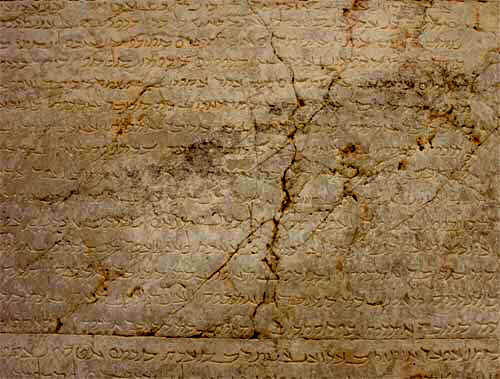
In your school, you learn about Kartir, the great Zoroastrian reformer and founder of Mazdeism (the Sassanid times’ reformulation of the Zoroastrian faith), imperial high priest, theoretician and mystic whose Celestial Voyage antedates that of prophet Muhammad (Mi’raj) – and not about the petty philosophers of Ancient Ionia, Macedonia, Thrace and Greece, who proved to be unable to fathom the spiritual universe in its true dimensions
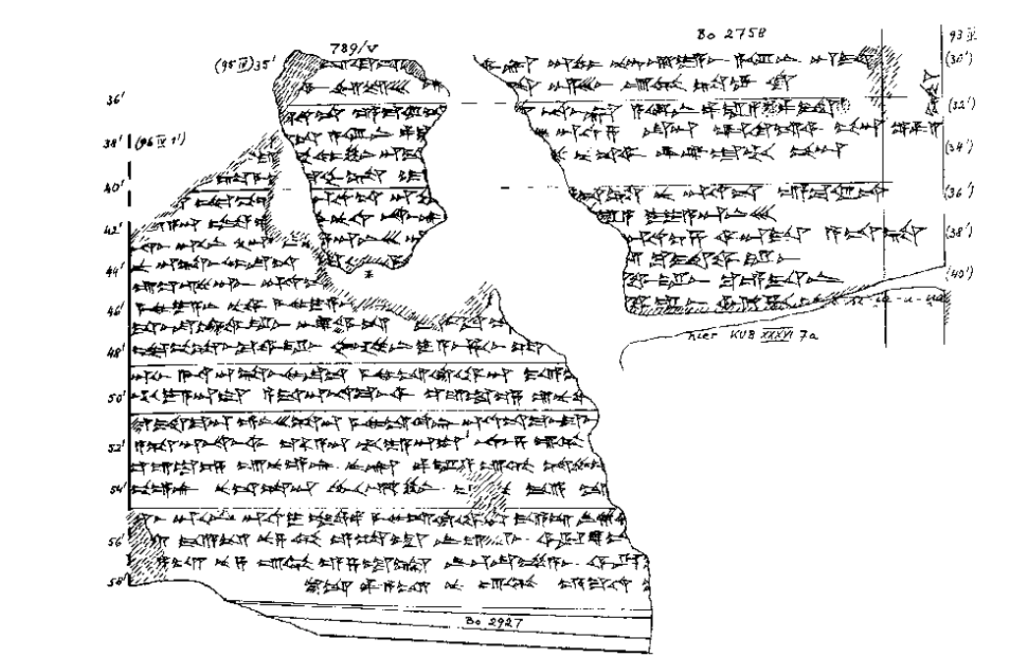
In your school, you learn about the eschatological Hittite Epic of Ullikummi – and not about the racist anti-Macedonian discourses of the Athenian demagogue Demosthenes
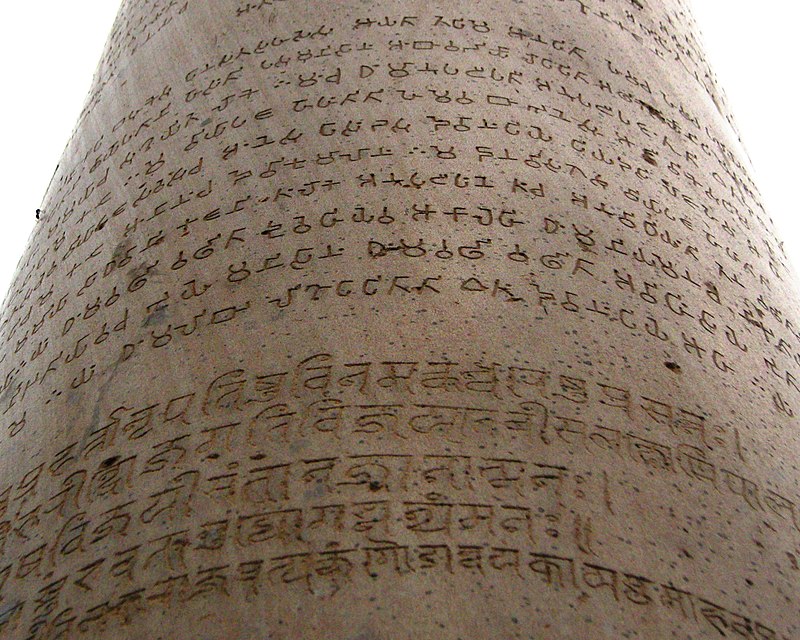
In your school, you learn about the Ashoka edict (on the Delhi-Topra pillar) – and not about Thucydides’ worthless narrative concerning the incessant wars among the petty kings and politicians of the tiny cities-states of Ancient Greece
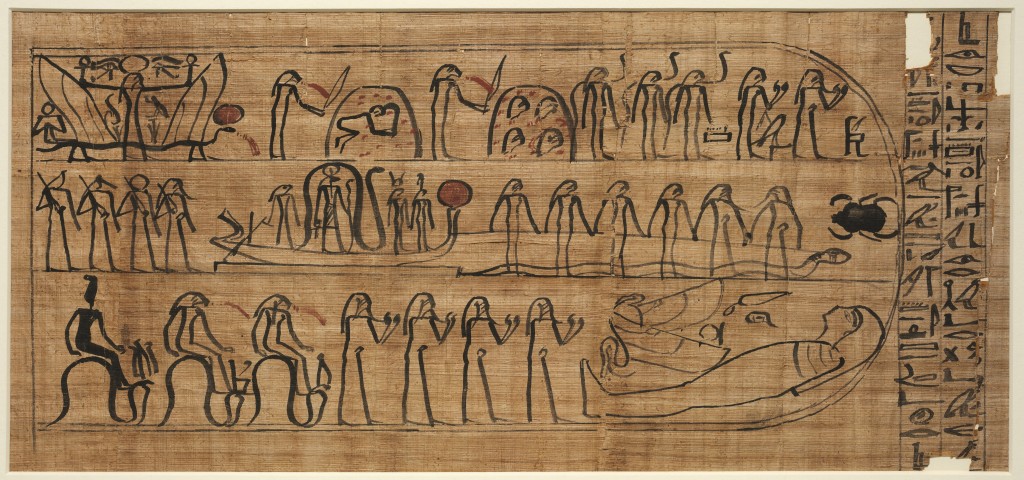
In your school, you learn about the Ancient Egyptian Holy Book Amduat that details events taking place in the Hereafter – and not about Julius Caesar’s boring historical description about how Romans killed one another, before massacring the inhabitants of Gaul
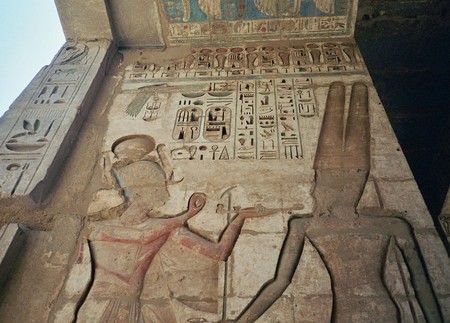
In your school, you learn about the Ancient Egyptian Expedition to Punt (Somalia) that was undertaken (ca. 1475 BCE) by Admiral Nehesy and the Imperial Fleet of Pharaoh Hatshepsut and became the object of a long narrative (texts and reliefs) inscribed on the walls of the first female pharaoh’s mortuary temple at Deir el Bahari, Luxor West – and not about the wrong stories of Diodorus of Sicily or Arrian’s description of Alexander’s military campaign

In your school, you learn about the Chinese Dunhuang Star map, the first known star chart (ca. 700 CE) from China, which contains the data collected from the three different schools of Astronomy that existed there – and not about Pausanias’ Description of Greece that has very limited value.
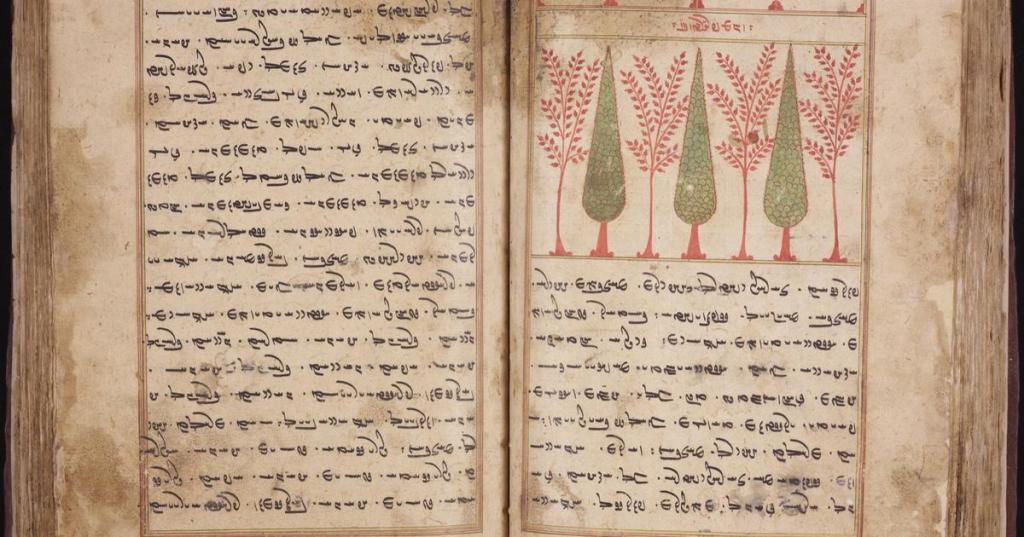
In your school, you learn about the Vendidad, which is the part of the Iranian Holy Book of Avesta that contains fragments from the discussion between Ahura Mazda and Zardosht (Zoroaster) concerning possible ways for humans to confound spirits and demons – and not Ancient Greek mythology where the Divine World is desecrated by Ancient Greeks’ fake and idiotic gods that were poorly conceptualized after sinful human behaviors and examples

In your school, you learn about the Dhammapada (collection of Buddha’s admonitions; here written in Gandhari language and Kharosthi writing) – and not about the verbose, worthless writings and the absurd scholasticism of Thomas Aquinas that constitute a major reason for the collapse of religiosity in the Western world
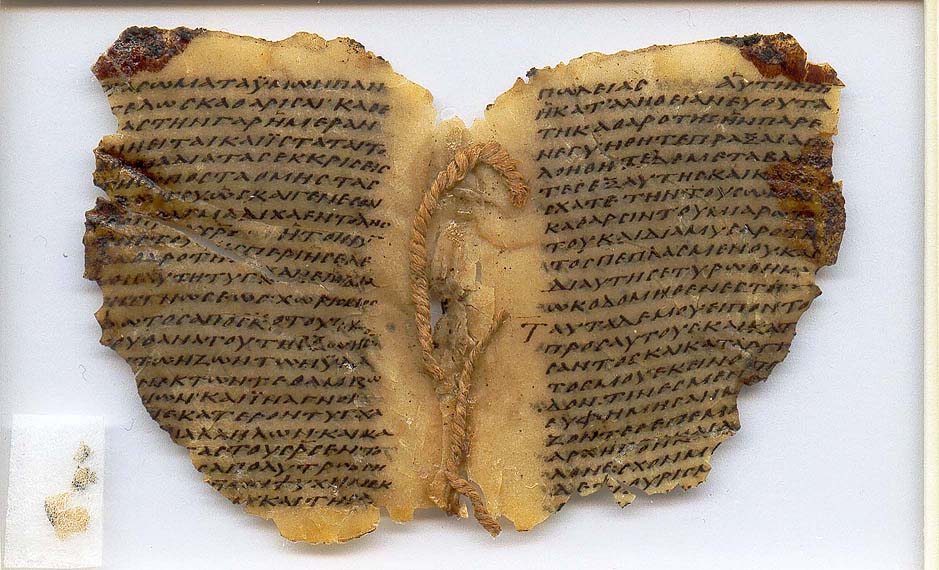
In your school, you learn about the Manichaean Evangelion (here as it is in the Cologne Mani-Codex), which was one of the seven holy books of the Manichaeans, who spread from NW Africa and Western Europe to North Africa to China – and not about Dante and his heinous Divine Comedy
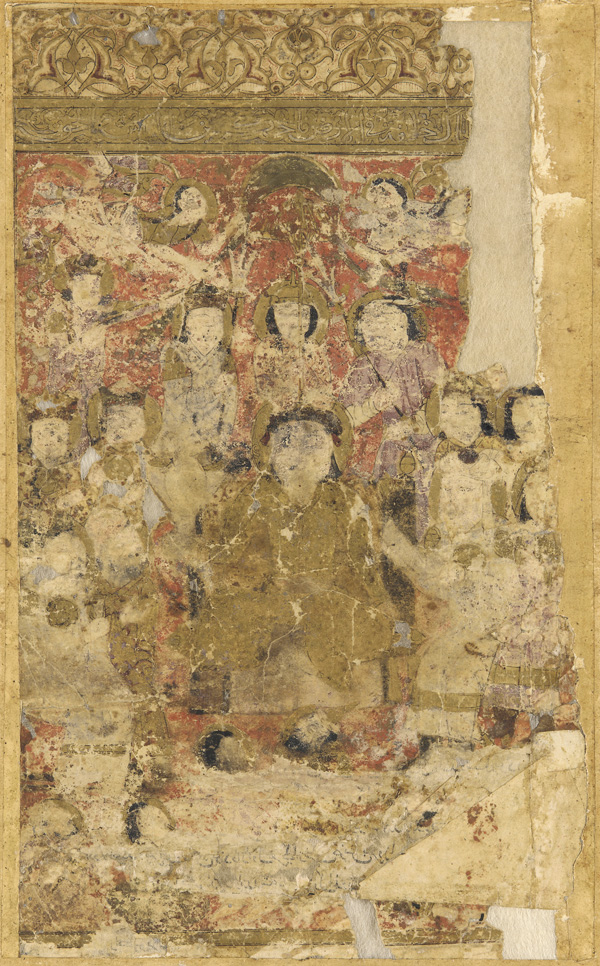
In your school, you learn about the greatest historian of Islamic times Tabari (9th – 10th c. CE) and his History of Prophets and Kings (here portrayed in a miniature of the historical Farsi translation of his monumental opus by Amirak Bal’ami) – and not about Edward Gibbon, an 18th c. English historian, who wrote only to distort, adapt Roman History to English colonial interests, and propagate concepts of white supremacism and racism
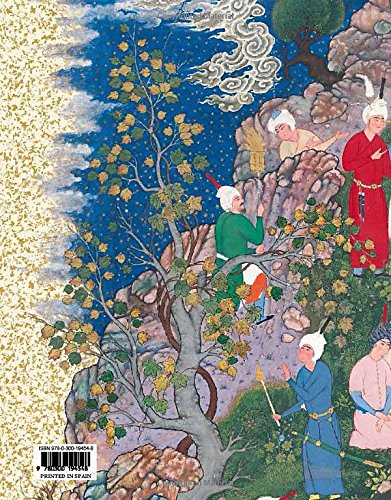
In your school, you learn about the greatest epic poet of Islamic times Ferdowsi (10 th c.) and his majestic Shahnameh (‘Book of Kings’) that was called ‘the Iranian Quran'(here a book cover with a miniature from the Shahnameh especially handwritten and decorated for Shah Tahmasp in the 16th c.) – and not about 17th c. French Classicist Theater

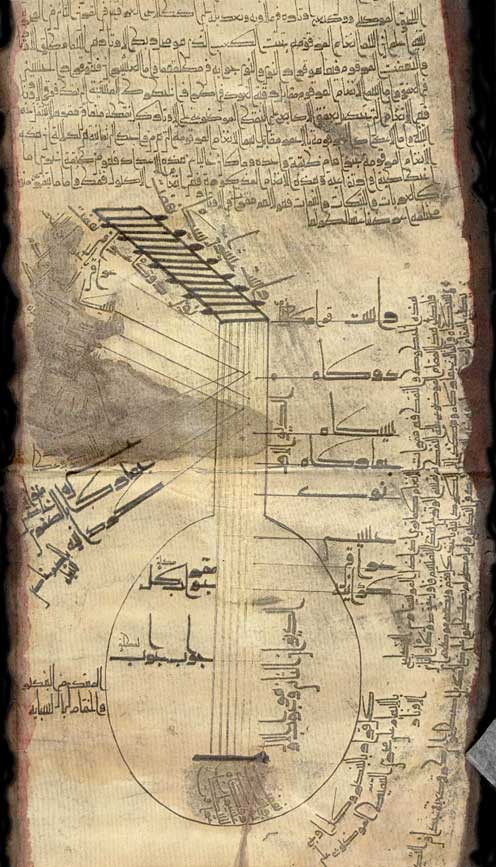
In your school, you learn about the great innovations and inventions brought about by the great Turanian scholar Al Farabi (9th-10th c.), who established a groundbreaking Zodiac chart (left) and conceived an eight string ‘ud/lute (right) – and not the fallacious calculations of Nicholas Copernicus.
——————————————————————-
II. How Western Europeans westernized Russians for 300 years
Russia is an excellent paradigm in this regard; as land, it was never colonized by any Western colonial country. Yet, today, Russia is extensively westernized and must be systematically and effectively de-Westernized. The discussion I had with an astute Russian reader sheds light on the innumerable niches of the de-Westernization (or detoxification or decontamination). I therefore publish it in its largest part.
– English Translation of a Comment Made by a Russian Reader –
Hello dear Shamsuddin.
I read your articles with numbers “IV” and “V” (while waiting for public transport and on the road). Be careful when referring to information from Wikipedia in your articles! I say this because this site regularly misrepresents information about my country.
Your article with the number “V” reminded me of the book by the Russian philosopher Povarnin “How to read books” and the American writer Adler “How to read the book”. After getting acquainted with these books, I realized that before my attitude to books was like to fast food: “quick breakfast / lunch”. And that I didn’t read a single book “correctly”.
After reading article “IV”, where you described Ancient Greece not as a State, but simply as a group of different people, I now can’t wait for you to read the book I recommended. They also show the “inconvenient” truth about Ancient Greece.
At the end of the article, I was struck by your idea of abolishing Shakespeare in school. I agree with this only if you meant that when you are young you cannot understand great works. To do this, you need to be older and so that life will harden you a little.
Last question.
There are authors who are unknown in Russia, or only one book out of many books of each of them has been translated. Could you evaluate which of these authors are “harmful” to the Russian public, and which should be known?
Sincerely,
Fedor.
————— My Response —————–
Dear Fedor,
Thank you for your points that will certainly empower me to better present my approach and to describe several hitherto undiscussed topics!
Reading and writing in transportation means, with or without a laptop (I never had and I will never have a smart telephone), has been for me a time-honored tradition; it involves trains, boats, ferryboats, airplanes, interurban buses, metro, trolleybuses, and buses. Also: taxis and private cars (of friends)!
As it happens with every series of articles, the complete idea about my approach you would get reading all of my five hitherto published articles about Russia, Ukraine and the world. My recent article-proposal for a new UN organization belongs -in a way- to this series, which is -never forget it!- ongoing. All the same, articles IV and V are quite representative; in the former, I expand on spiritual topics {because there is spiritual dimension in this conflict/the difference between Earth and Sea viewed as primordial elements of the Creation (in forming people and societies opposite to one another: ‘continental’ and ‘maritime’)}, whereas in the latter, I focus on educational issues and I expand on how to perceive History of Northern Asia and Northeastern Europe as History of Russia.
Now that you read article no V, you can easily read article no II, which is an entire repositioning of the History of Russia; this means that article no II serves as the foundation for article no IV. In it, I expand more on the long and wide historical continuity that you must focus on, instead of minimizing Russia’s history to an ethnic narrative of ‘Slavic’ tribes that accepted Christianity in Kievan Rus. Your History, the History of all Russians, is far larger than that; Western linguists, Slavologists and historians did their best to limit your view of your past and to make you see it as a ‘racial history’ (or an ‘ethnic history’ if you want) only to your disadvantage. History is not a narrative of ethnic groups and races, but a description of cultures and civilizations.
By making you focus on a limited past and by dragging you in a way that you use the racial-racist approach to your past (that they invented for others – haha! but not for themselves!!), they subtly bring you to a frontal clash with Turanian (Turkic) nations and with Muslims; this will be disastrous for Russia and for the entire world.
You must understand (and I don’t speak personally but generally for all Russians, your government included) that, for the evil Western forces, ‘politics’ starts with History, continues with Education, advances with Culture, and ends up with Political Philosophy and Ideology, which forms the context of what people call now ‘politics’, but in reality is ‘governance’.
What is called today ‘Western world’ is a fallacy that started with Renaissance and the early colonial empires, namely Spain and Portugal, but when it comes to the way modern countries are governed, the two Iberian kingdoms are obsolete forms of state that are closer to Ivan IV’s Muscovy, to the Eastern Roman Empire or even to Sassanid Iran. The structure of contemporary states originates from end of 17th c. Holland and post-Cromwell England. In this evil form of tyranny, everything is utilized in (i.e. distorted in order to be fit to) politics.
——————————————————————-
Muscovy, a Christian-Muslim, Russian-Tatar, Asiatic City
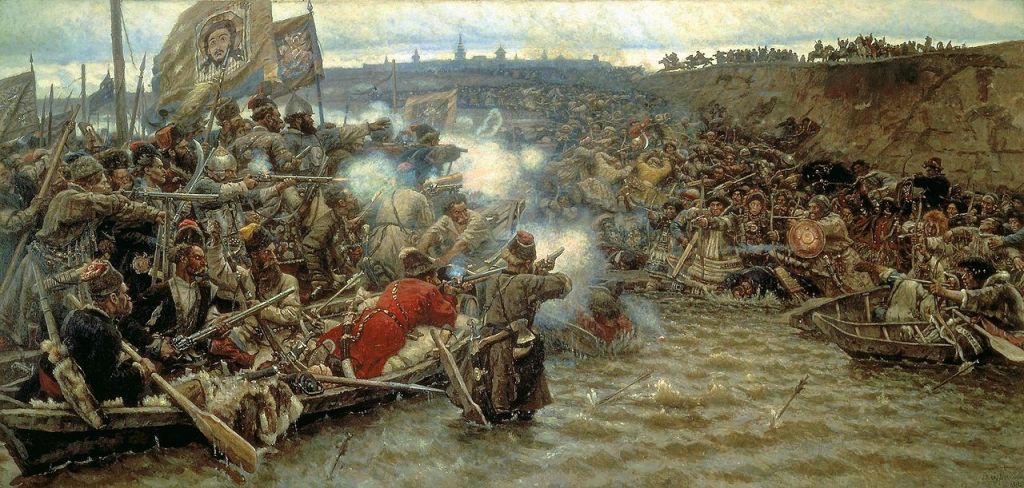
The Conquest of Siberia by Yermak; painting by Vasily Surikov. In the 19th c., despite their advanced cultural-educational Westernization, Russian painters like Surikov reproduced a totally non-Western ‘image’ of 16th c. Muscovy and Russia.The Russian Soul is this.
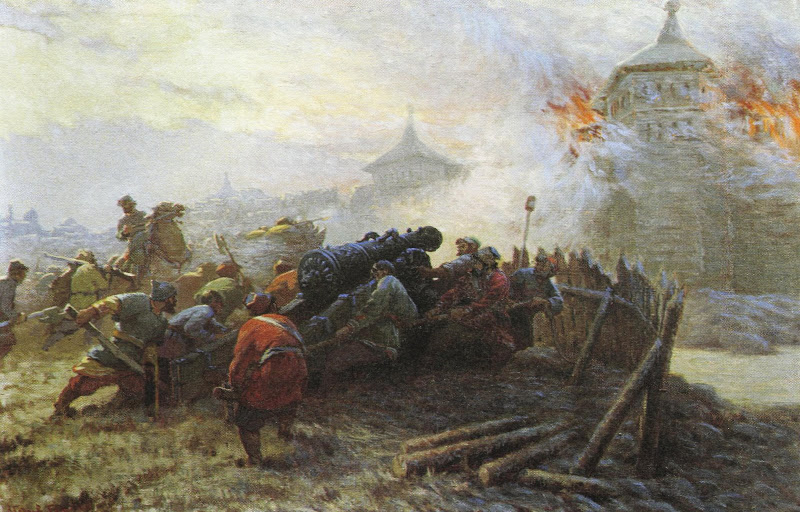
The Siege of Kazan; painting by Vladimir Stepanovich Bodrov
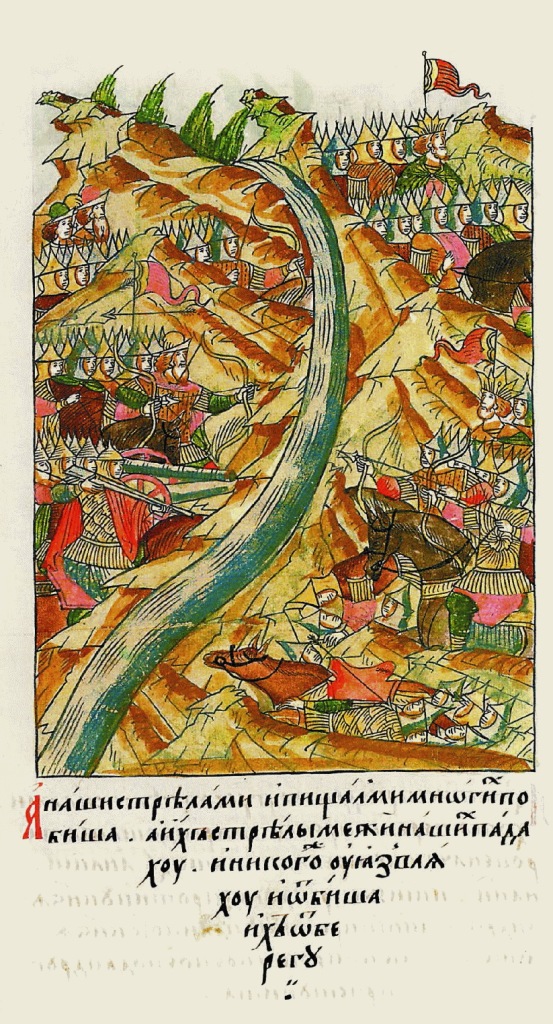
‘Battle’ of the Ugra, 1480; from 16th c. miniature – The ‘battle’ took place because Ivan III did not want to pay tribute to the Great Horde; Ahmad Khan bin Küchük led the Tatar forces. It is a critical and quite odd historical moment, because the two armies stood on the opposite banks of the river and, in spite of tricks and threats, no battle was fought, and at the end, the two armies withdrew. It is not correct to consider this date as the beginning of Muscovite independence, because the Muscovites continued being vassal to the Tatars of Crimea. The overall situation was far more complicated, because Poland sided with the Tatars of Sarai, whereas Ivan III was supported by the Khan of Crimea; even more so, because the Great Khan was later killed by the Khan of Siberia and his Nogay Turanian allies.
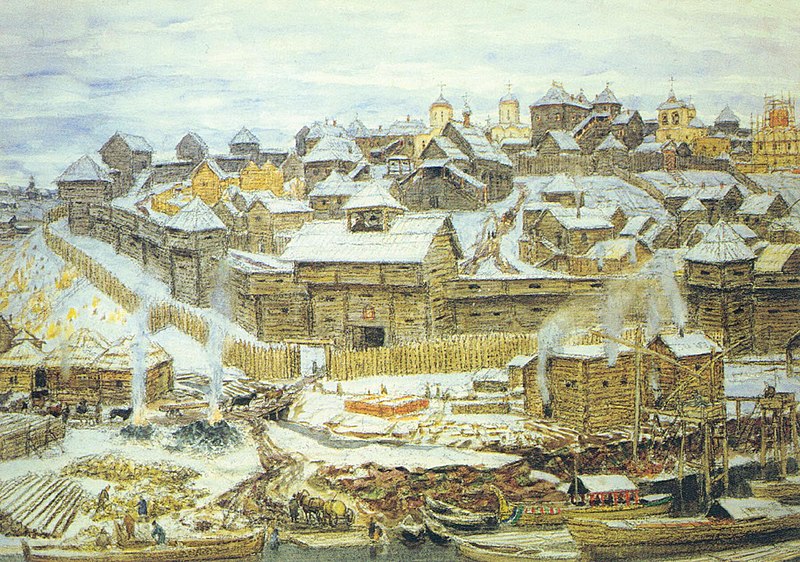
Muscovy at the time of Ivan Kalita (early 14th c.), painting by Apollinary Vasnetsov (19th c.): apparently an Asiatic town that had nothing to do with Western European norms.
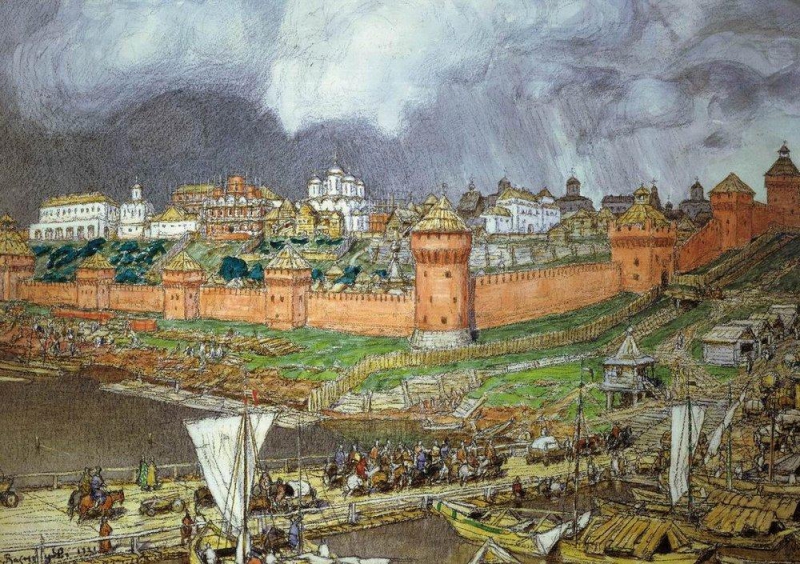
At a time of advanced Westernization, the famous Russian painter Apollinary Vasnetsov (1856-1933) felt the need to represent, based historical accounts, ‘Muscovy at the time of Ivan III’, thus fully revealing the entirely Oriental and Asiatic nature of his fatherland.

‘The Last Minutes of Metropolitan Philip’ painted by Aleksandr Nikanorovich Novokoltsev (1853-1919) in 1889 was the way the illustrious Russian painter evoked the awaken in the 15th c. Muscovite spirituality that had gone extinct in late 19th c. Imperial Russia due to the multi-layered and advanced Westernization; the painting also reflected the wrongdoings of Ivan IV the Terrible, who ordered the assassination of Philip II (1507-1569) because the thirteenth (13th) Metropolitan of Muscovy (1567-1568) rejected to bless him due to the Oprichnina system of persecution against the boyars (the wealthy and powerful landlords).

‘Ivan the Terrible and Associates’ painted in 1903 by Andrey Ryabushkin (1861-1904): there was nothing Western in Ivan IV.
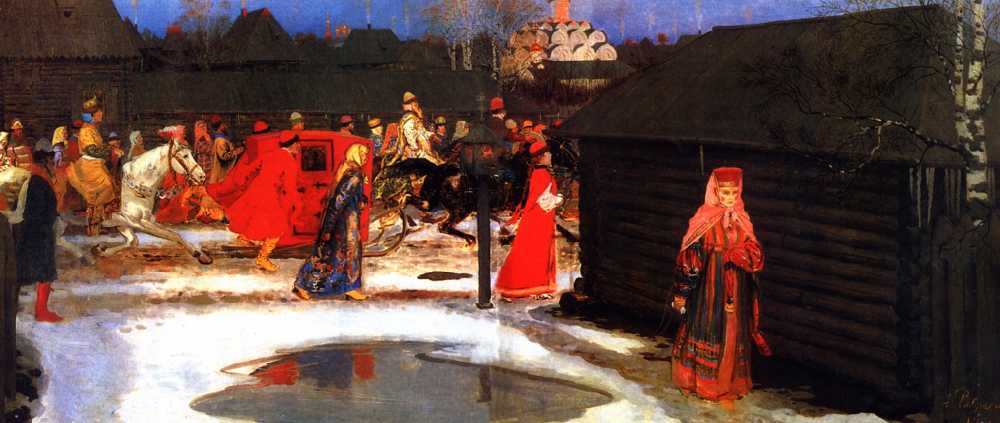
Andrey Ryabushkin’s ‘Wedding train in 17th c. Moscow’ (1901) demonstrates that Russia was an culturally Asiatic realm.
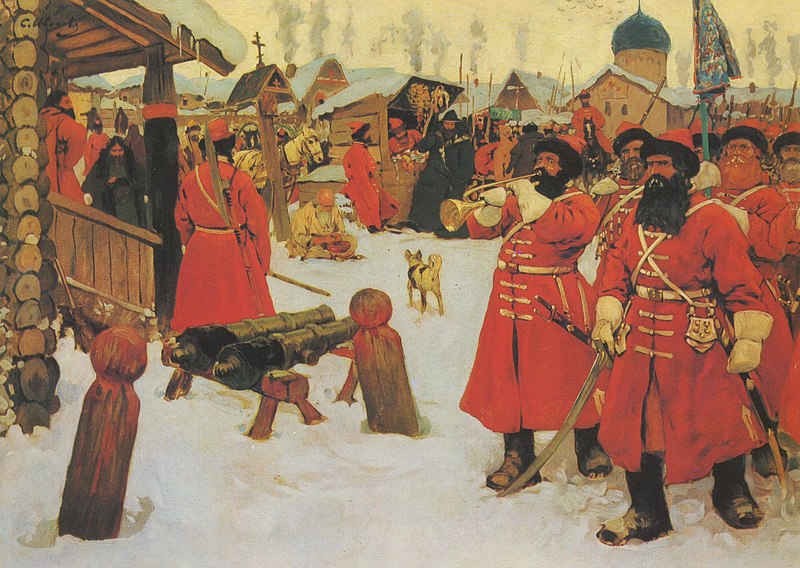
‘Streltsy’ (the accent being on the last syllable / ‘Стрельцы’: infantry carrying firearms) painted in 1907 by Sergey Vasilievich Ivanov (1864-1910): one more evidence that the Westernized Russian elites of the beginning of the 20th c. felt an inexorable nostalgia for their totally non-Western past and heritage (Streltsy existed as military units from the mid-16th to the 18th c.)
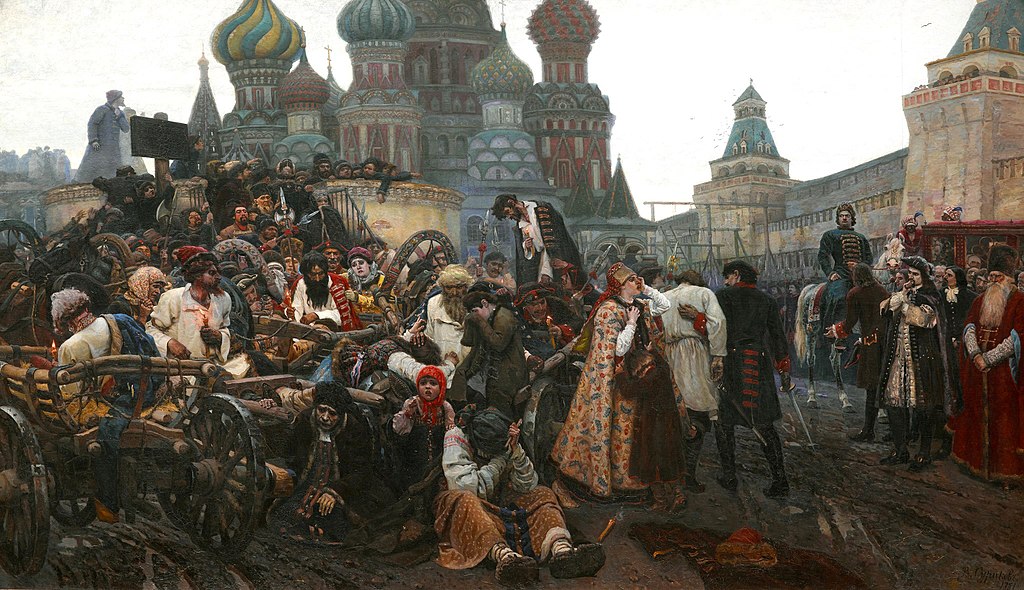
‘The Morning of the Streltsy Execution’ painting (1881) by Vasily Ivanovich Surikov (1848-1916) helped spectators recall a critical historical event that took place in 1698, when Russia had almost no Western cultural or imperial attribute: the great uprising of the glorious military unit, which was due to the fact that the Streltsy rejected the vicious project of Westernization that Peter I wanted to introduce and the disastrous (because uncontrolled) presence of foreign (Western) advisers. Quite indicatively, an English soldier, Patrick Leopold Gordon of Auchleuchries (1635-1699) commanded the army that killed the genuine Russian officers in battle. All those, who were not killed in the Battle of Voskresensky (Resurrection) Monastery, which is also known as New Jerusalem Monastery, were executed in Moscow (between September 1698 and February 1699): more than 1000 noble soldiers – early victims of Westernization.
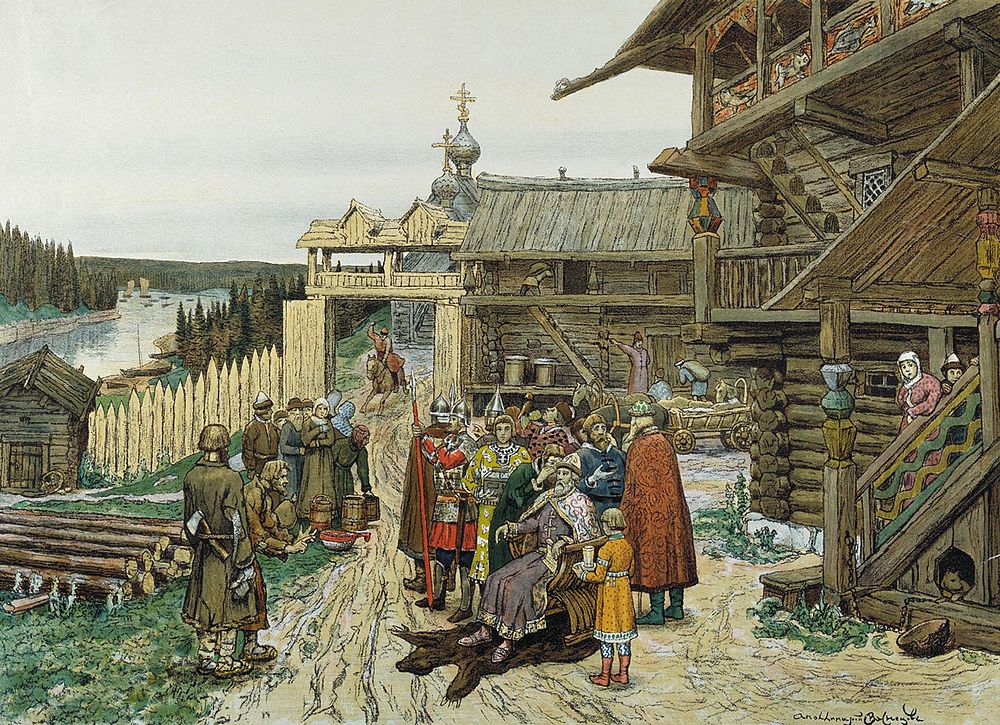
Daily life in 15th-16th c. Muscovy: ‘Courtyard of the specific prince’, painting by Apollinary Vasnetsov (1908) / About: https://ru.wikipedia.org/wiki/НаселениеДревнейРуси
——————————————————————-
If you think that you can oppose, England, France and the Western world at the ‘political’ level, you are deceived and you will fail, because it was ‘politics’ to their elites
a. how to Occidentalize / Westernize Peter I;
b. how to progressively detach the executive of the Russian Empire from the Eastern Roman (falsely called ‘Byzantine’) imperial tradition and to drag it to sheer imitation of the Western pseudo-kingdoms;
c. how to corrupt the Russian elites by initiating them to various orders particular to the Freemasons, the Jesuits, and even the Zionists;
d. how to attach the Russian academic and intellectual elites to the fallacies of Renaissance, Classicism, Hellenism, Enlightenment, European Classical Music, and the Greco-Roman foundations of Modern European White Supremacism and Racism;
e. how to engulf Russians into Pan-Slavism in order to bring Russia in clash with Germany and Austria-Hungary;
f. how to ‘teach’ the Russian elites that ‘being Christian Orthodox’ meant ‘being anti-Muslim’ and thus engulf them in wars against the Iranians and the Ottomans; and
g. how to link Russia ‘historically-culturally’ with Classical Greece and Rome (which is wrong and disastrous) and how disconnect Russia ‘historically-culturally’ from Ancient Orient (Caucasus, Anatolia, Mesopotamia, Syria-Palestine, Iran, Central Asia, China and Indus River Valley), which is also erroneous and calamitous.
———————————————————–
The Westernized Russian elites and their non-Russian venues
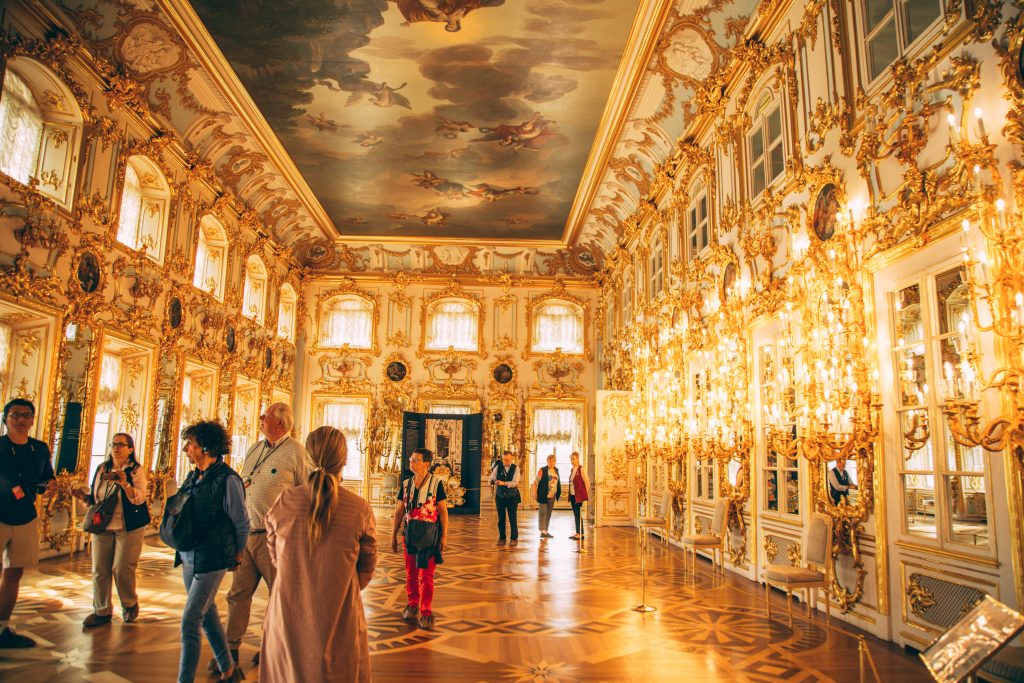
Peterhof Palace, St. Petersburg: Peter I’s ‘response’ to Louis XIV’s Versailles. All the same, this conventional approach is an oxymoron indeed, because in reality, the monumental palace was a ‘French’ (not ‘Russian’) response to something French!
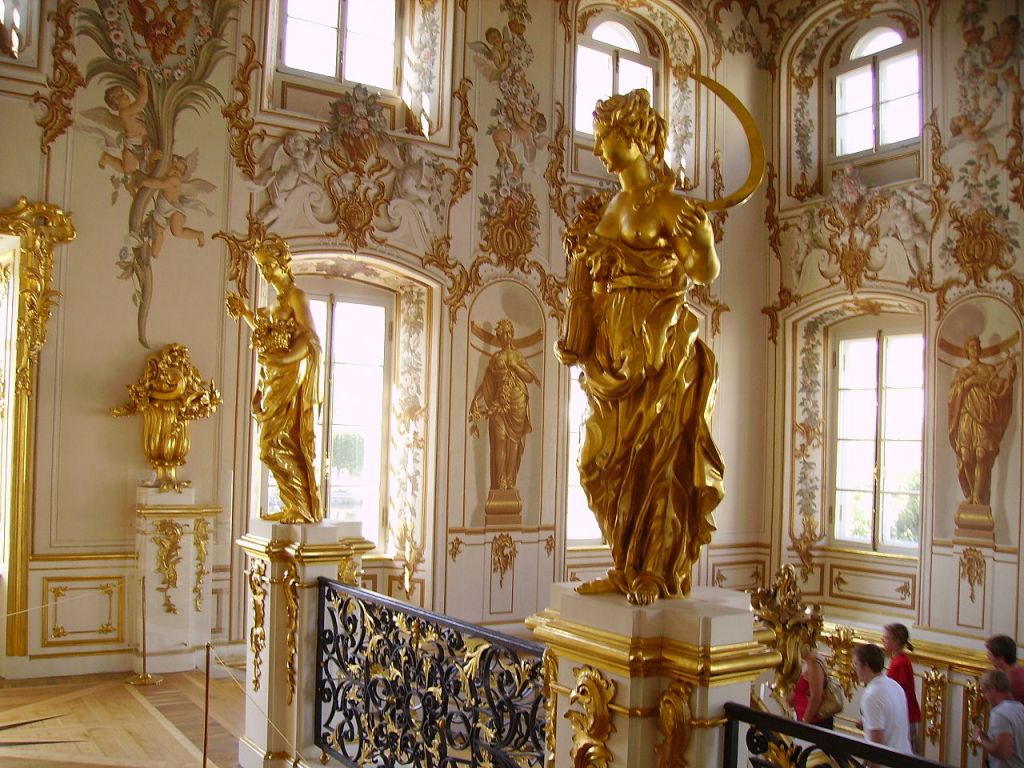
Peterhof Palace, the main staircase

Peterhof Palace, the main staircase
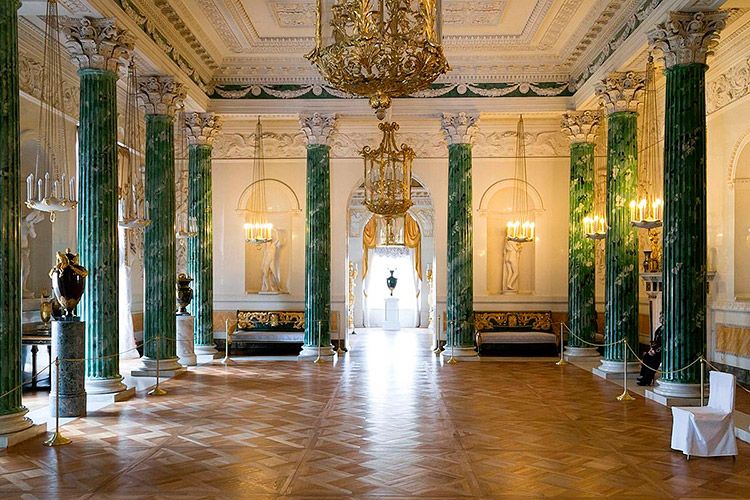
The Greek Hall of Pavlovsk Palace

State Bedroom at Pavlovsk Palace
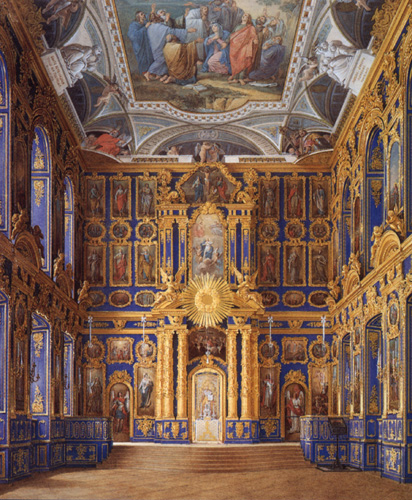
This is the Freemasonic ‘chapel’ in the Catherine Palace, St. Petersburg; the quasi-totality of her empire’s Christian Orthodox population would not find it proper to pray there. Along with Westernization in Architecture, Art and Religion comes the historical falsification that took the form of the Occidentalization of Russian History. Leading example in this regard is Nikolay Karamzin (Николай Михайлович Карамзин; 1766-1826) who wrote his 12-volume History of the Russian State (История государства Российского) only to break with the earlier Russian historiographical tradition that was exemplified by Vasily Tatishchev (1686-1750). Both distinguished Russian historians are described as proponents of autocracy, but this is very erroneous; actually, it looks like a deliberate effort to confuse specialists and average readers. Karamzin’s advanced Westernization made him write after French prose style and his exposure to Occidental post-Renaissance concepts made him introduce alien and corrupt elements (like Hellenism), insult Ivan IV Terribl,e and slander the true Russian identity – only to the benefit of the dark forces that incessantly promoted Russia’s rapid Westernization. What went wrong with Karamzin? This is easy to answer: in 1789, he traveled to Germany, France, Switzerland and England. This was an enormous mistake. He should have traveled to the Ottoman Empire, Qajar Iran, Mughal India, and Qing China instead.
———————————————————–
III. Unreliable Wikipedia
You mention the Wikipedia, the encyclopedia of sophisticated distortion, alteration, historical falsification, and adaptation of the historical truth to the ideological-political needs of the Western world’s ruling elites.
You misunderstood my attitude to constantly add numerous Wikipedia links to my articles.
I do not “refer to information from Wikipedia”; I only mention links to Wikipedia entries, so that my readers find them easily, go there, make their own search, check the notes, sources and bibliography, and thus have access to more specialized info that they may want, after reading some of my points.
As I do so quite often, in several articles I have already stated that I disagree with the contents of most of the Wikipedia entries that I mention. Now, your point makes me understand that I should perhaps prepare a 3-5 lines text about this issue, and copy / republish it in each and every one of my articles.
IV. Reading texts & reading in-between the lines of texts
“How to read books”! You raise an enormous topic.
Basically, you mean that one person must also read in-between the lines of a text.
That is very correct.
The real essence of the reality is never in the words of a text.
In fact, a word -in itself- is almost nothing.
Semantics is a field of ignorance and paranoia.
Ancient Greek philosophers’ opinions on these topics were childish and nonsensical; this was due to their low level of understanding the Ancient Egyptian, Assyrian, Babylonian and Iranian priests next to whom they studied for years.
Realities do not exist because humans exist; they exist on their own.
Only God knows the purpose of every element of the Creation, and the interminable possibilities that they have to amalgamate with one another. You can never know anything before duly identifying the composition of the elements that constituted it: Ether, Soft Waters, Earth, Air and Salt Waters.
Nothing is signified or denoted by a human; everything is signified per se – by itself. When someone speaks, describes and narrates about something, he only shows what he understood from a tiny part which belongs to a world created by the Almighty God. Our understanding is merely our revelation: what we reveal (and therefore represent to us and others) out of the infinite universe that God created. As God is invisible, the link of the tools that a speaker or narrator uses is invisible. Yet, without this link, all the words of a sentence are meaningless and can be re-arranged in a way so that they mean, reflect and describe other realities.
All the same, at this point, I should add that, in reality, language is not necessary for communication; it is only a low means of communication. Animals and even insects communicate with one another better than humans do. This fact deletes the stupidity of the idiots like Aristotle, and at the same time it demonstrates that longer we stick to rationalism and the Aristotelian thought, farther from the truth we will be and deeper into wars and misunderstanding we will be plunged.
A man, who has not awakened in the spiritual universe, can never have a clue of what exists in the material universe; this is so because nothing was created in the material universe without a counterpart (soul, spirit, etc.) in the spiritual universe. For this reason, the sciences of all the ancient Oriental nations were comprehensive systems of learning that combined spiritual and material research; ancient scholars never dissociated the spiritual aspect from its material complement of an item, point or issue. Consequently, every man reads a text differently from another, according to their progress in being re-connected with their soul.
Otherwise, one needs to stop in almost every line of a text and make questions about what he reads in order to extract further details and, above all, reach and grasp the deeper meaning of the text.
You are lucky that you realized this issue, namely that you had not read even one single book correctly, before you understood that this serious trouble was real. Most of the people do never reach that level. Even worse, in our days, there are many professors, specialists, experts, researchers and intellectuals who do not reach the point that you mention. They then project their mentality and knowledge, opinion and predilection onto the text that they read, and they don’t truly read the text that they have in front of their eyes, but an imaginative text that they create by failing to separate their personal delusion (i.e. their sick ego/I say ‘sick’ because ego is always so) from the true text that they supposedly read.
V. Rejection of the fallacy of Hellenism: starting point of every effort of De-Westernization
There is no ‘inconvenient truth’ about Ancient Greece. Your sentence is a minimal understatement.
In fact, there is a devastating truth, as documented by numerous sources, which simply deletes once forever the dreadful forgery ‘Ancient Greece’, which never existed.
Whereas Ivan IV and the Muscovites of his time knew the truth, i.e. knew nothing about Ancient Greece, you live within an enormous falsehood that had started being elaborated in Western Europe; thence it was diffused already in the last days of Tatar-Muslim prevalence in Russia. However, it took some time for this falsehood to be diffused outside Western Europe, which is the region where it was produced. The period of the diffusion of this enormous fallacy we call ‘colonialism’. Russia was never colonized at the military level, but even at the times of Romanov, it was colonized at many levels, namely political, economic, socio-behavioral, artistic, educational, academic and intellectual.
The Western European falsehood about Ancient Greece does not only involve distortion and misinterpretation of Ancient Greek and Latin sources, but it also includes systematic and extensive concealment of other historical sources. Now, this concealment is disproportionate, extraordinary and unprecedented. It starts with the Western scholars, who first explored Anatolia, North-Northwestern Africa, Egypt, Syria-Palestine, Mesopotamia, Iran, Caucasus, Central Asia, Sudan and Eastern Africa, Yemen, India, and China. These people, before traveling to explore, had studied all Ancient Greek and Latin texts about those lands, peoples, monuments, faiths and civilizations. As you can understand, these views and standpoints were external, irrelevant, erroneous and at times nonsensical. In fact, they did not consist in an authoritative source about those nations, empires and histories.
Herodotus’ and Plato’s descriptions of Iran and Egypt are ridiculous, idiotic and utterly valueless; they have the ‘value’ that an ignorant traveler’s idea has about a land that he has no skills, stamina and predisposition to duly study. The same is valid for other Ancient Greek travelers’ narratives about Mesopotamia, Phoenicia, Iran, Anatolia, Egypt and other regions. Those guys did not know even the correct terms to describe the achievements and the traits of the great civilizations they wrote about, let alone the vast theoretical-spiritual background that these terms reflected.
Beyond that, there is an even more disastrous comparison: although there are -in Ancient Oriental sources- many references to the various and different nations that modern European scholars name “Ancient Greeks”, these passages are relatively few, brief and secondary because simply the Ancient Ionians, Aeolians, Achaeans and Dorians were not civilized enough to possibly attract the interest of the Hittites, the Assyrians, the Hurrians, the Babylonians, the Canaanites, the Egyptians and the Iranians. Ionia and Aeolia in Western Anatolia produced a civilization lower than that of the Phrygians and the Lydians who were better documented in Assyrian cuneiform sources. Even more importantly, Greece, i.e. the most confined part of the Balkan Peninsula, south of Mount Olympus, was a peripheral land far from the great centers of civilization.
Only when a serious trouble originated from those lands, like the Peleset-Pelasgian-Philistine reaction against the Achaean siege and destruction of Troy, we have longer descriptions in Oriental historical sources. This was the case of the ‘Sea Peoples’, as the Ancient Egyptians called the Peleset and their allies, Trojans included. When, as allies of the Hittites, the Achaeans were asked to attack Troy and they achieved to conquer the highly important city, the reaction of the enemies of the Achaeans, namely the Pelasgians, was forceful.
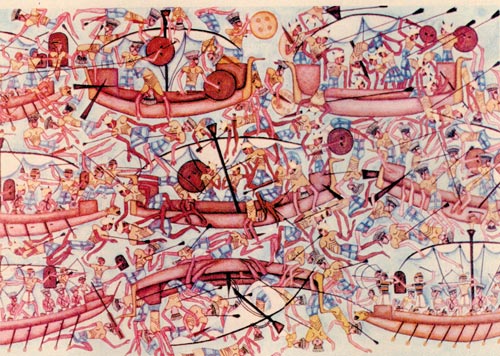
Near colorization of part of the bas-reliefs
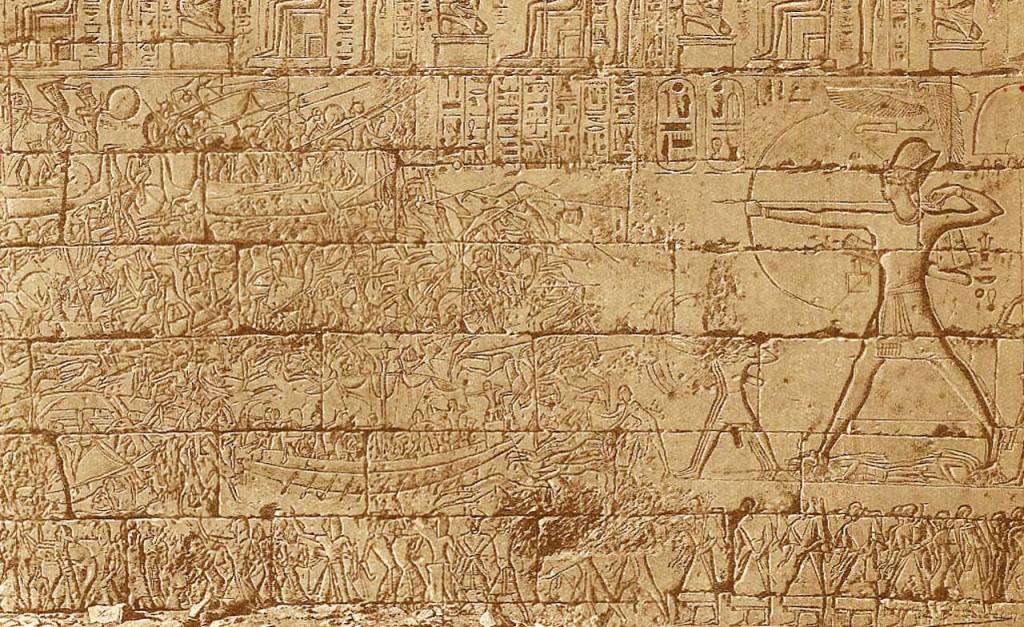
Part of the bas reliefs of the northern external wall of Ramses III’s mortuary temple at Medinet Habu (Luxor West); texts and bas-reliefs full narrate the three battles that Ramses III won to disperse the Sea Peoples.
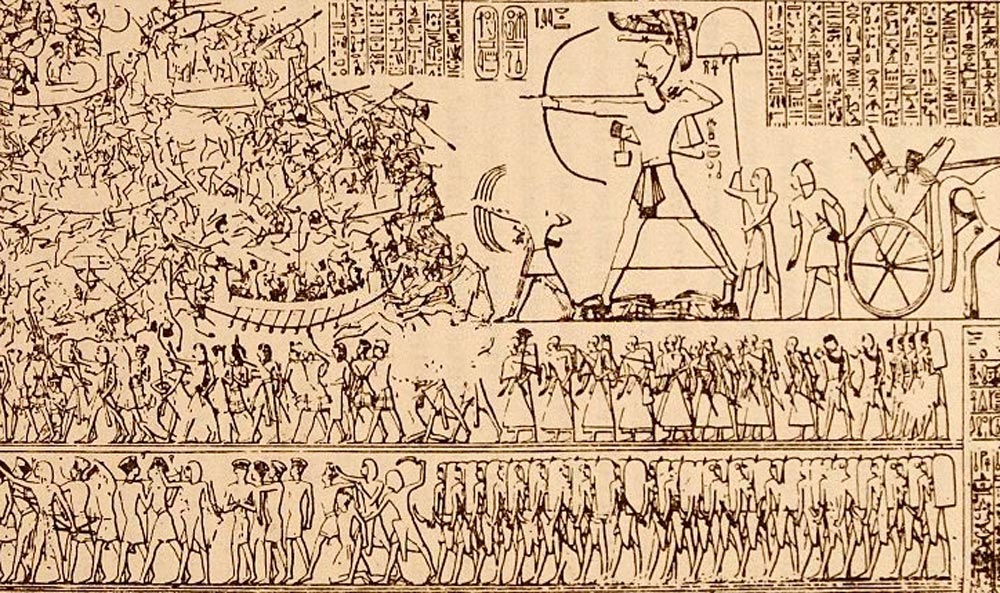
Drawing of a larger part of the bas-reliefs
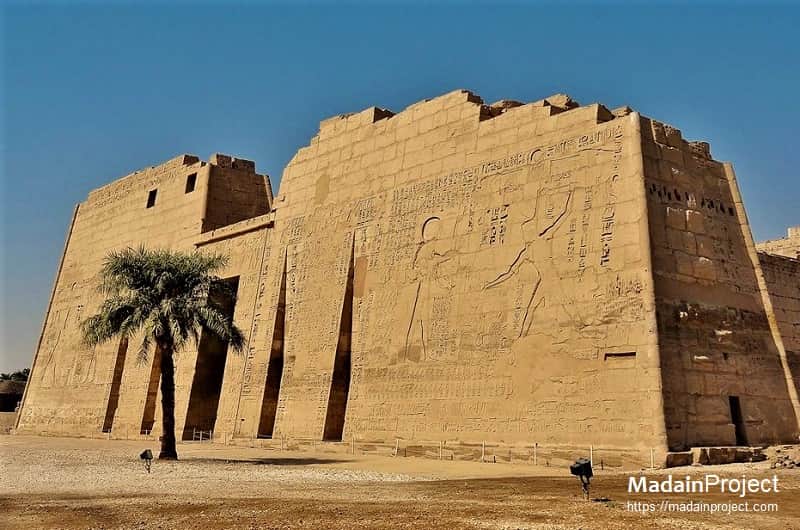
First pylon of the Medinet Habu temple
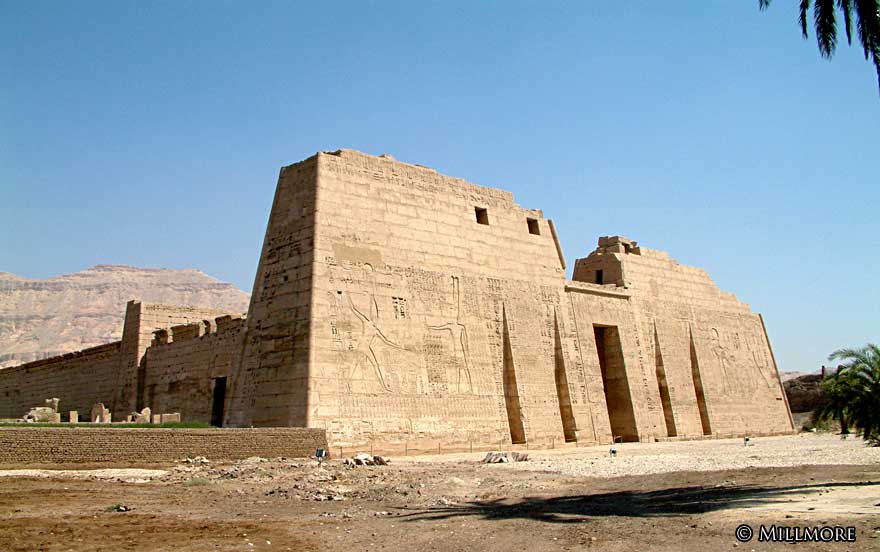
Ramses III’s mortuary temple at Medinet Habu (Luxor West); view from the southeast
The Anti-Achaean and Anti-Hittite Pelasgians formed an alliance and then rebelled against the Achaeans and ruined them (which is mentioned in the Ancient Egyptian texts and archaeologically evidenced as the conflagration of the Mycenaean fortresses), attacked Hattusha and destroyed the Hittite Empire, invaded the Canaanite coast of Eastern Mediterranean, notably Ugarit (a small kingdom but the Ancient World’s greatest library and center of Translation), and Amurru (today’s Syria), and ultimately attacked Egypt (Kemet).
There Ramses III, after three battles, was able to destroy and disperse the Sea Peoples. The Peleset/Pelasgians, who took part in the invasions, settled in the coast of Southern Canaan and became known as the Philistines / Palestinians. Ionia and Aeolia in Western Anatolia and Ionians, Achaeans an Dorians in the South Balkans (‘Greece’) were plunged in abject misery and barbarism for 400-450 years (1200-750 BCE). When the epic cycle’s most famous poet Homer wrote about the deeds of the Achaeans, he in fact galvanized his contemporary fellow men and called them to form kingdoms and states after the Achaean example and to propagate the pro-Achaean and anti-Pelasgian version of History and narrative (rhapsody) that he composed. But all this was marginal, unimportant and trivial to the Assyrians, the Egyptians, the Babylonians, and the Iranians.
So, this is the disastrous comparison I spoke about earlier:
1- the highly civilized nations of the Ancient Orient did not bother to describe the petty stories, absurd regimes, and endless strives that characterized all those uncivilized and peripheral tribes; and
2- the hardly civilized, ignorant and uneducated Ionians, Aeolians and Dorians, originating from tiny cities-states, which were at times smaller than the area of a major Egyptian temple (like that of Karnak, Luxor), traveled to study in Egypt, Mesopotamia and Iran (6th – 4th c. BCE), but failed to duly conceive the spiritual and the material universes after the local spirituality, wisdom, science and imperial culture.
That is why, when these people returned back to Ionia, Aeolia, Thrace, Macedonia, Illyria and Greece, they called themselves ‘philosophers’, i.e. ‘friends of wisdom’. In reality, this term is very modest, if not pejorative; this is so because it means that they were not ‘sophoi’ (wise) and they did not possess ‘sophia’ (wisdom). So, they were merely ‘philosophoi’. This means that all those guys, like Thales, Pythagoras, Heraclitus, Parmenides, Democritus, Plato and others (who have been propelled to undeserved consideration and absurd evaluation by Western European scholars and intellectuals), knew very well that, in front of an Egyptian, Babylonian or Iranian (Zoroastrian) high priest, hierophant and mystic, they were humble and puerile schoolchildren.
Now, the low position of the peoples of South Balkans and Western Anatolia opposite the great Oriental civilizations is extensively reflected in the Ancient Greek texts. Plutarch wrote about the Ancient Egyptian Iwnw Heliopolitan religion (involving Osiris, Isis, Horus, etc.). But no Egyptian priest bothered to write about the petty cults of the clownish pseudo-divinities of the Ancient Greeks (Athena, Hera, Hermes, Poseidon, Zeus, etc.). The reason for this is double:
1- in many cases, the names of the Ancient Greek ‘gods’ were of Oriental origin, and
2- in every case, the cult was weaker and the spirituality nonexistent.
In striking opposition to the aforementioned historical realities, the 19th – 20th c. Western European explorers of colonial times, after their discoveries, excavations, decipherments, representations, essays, treatises and publications about Ancient Oriental civilizations, continued having the Greco-centric and Romano-centric approach that they had prior to their expeditions, researches, vast collection of documentation, and remarkable knowledge acquisition.
Although the texts and the monuments that they unearthed totally canceled their earlier knowledge (which was based on Ancient Greek, Latin and Hebrew sources), the Western European Orientalists continued preposterously viewing the anterior (the Ancient Oriental civilizations) through the eyes and the criteria of the posterior which was apparently lower and corrupted.
This absurd attitude only corroborates the fact that what the Western European scholars saw as ‘Ancient Greece and Rome’ was not what is documented in and reflected from Ancient Greek and Roman sources, but their biased delusions and preconceived schemes of racist nature.
For this reason, the Western European scholars did not modify their measures, standards and approaches, after the discoveries made over the past 250 years. They still stick to an absolutely obsolete and fully delusional model that -even worse- they want to impose onto Russia, India, China, Africa, Latin America, and all the Muslims of the world.
You understand of course that this model is false and disastrous in two dimensions:
1- first, it is an evolutionist model that serves to propagate the false concept that in the past the humans were uncivilized and that they progressed gradually until they reached the modern times, and the Western sciences. This is entirely wrong, because the Sumerians, the Akkadians and the Egyptians before 4500 years had spiritual and physical capacities that they gradually lost. It goes without saying that Western scholars want to hide this truth.
2- second, the Greco-Roman model that they intended and tried for more than 550 years to impose encompasses all the evil and corrupt elements that the forces, which selected it, need to diffuse and impose worldwide.
The clash between Orient and Occident is a fake, and that’s why they needed to diffuse Aeschylus’ sickness, paranoia and anti-Iranian racism and Herodotus’ silly lies and heinous bias.
The case of Ctesias clearly helps us understand that the ancient manuscripts must have been drastically tempered with by Catholic monks who copied them. So, there is an extra aspect to examine, analyze and comprehend in this regard.
———————————————————–
Ctesias could not make mistakes; others put lies in his mouth!
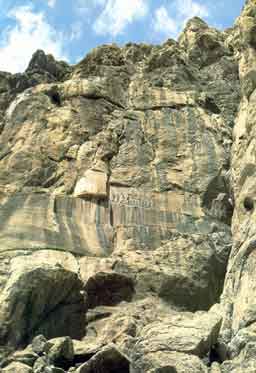
Behistun, NW Iran; the cliff with Darius I’s relief and inscriptions
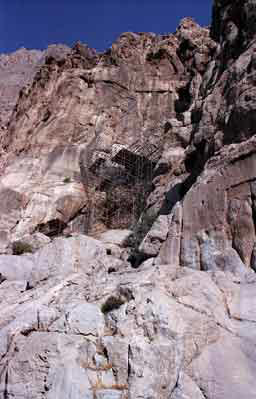
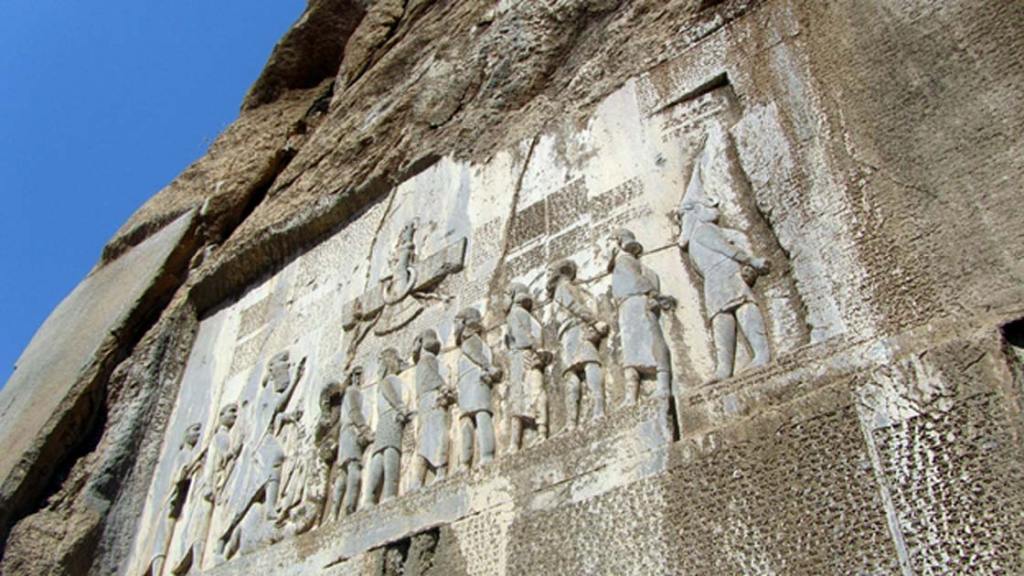
Behistun (Farsi: Bisotun / Old Iranian: Bagastana, i.e. ‘the place of God’ / Ancient Greek: Βαγίστανον όρος) was mentioned by Ctesias, who totally misunderstood the inscription, attributing it to the ‘Babylonian’ Queen Semiramis and describing it as a dedication to Zeus! In reality, the text is part of the Annals of Emperor Darius I the Great, duly detailing his victory over a rebellion; the Iranian monarch dedicated his triumph to Ahura Mazda. However, Semiramis seems to have been an entirely misplaced Ancient Greek legend about the historical Queen of Assyria (but not Babylonia!) Shammuramat. The Assyrian queen was the consort of Shamshi Adad V; she has also been mentioned in the original, Assyrian cuneiform sources as co-regent during the early phase of her son Adad-nirari III’s reign (811-783 BCE). But the Assyrian Queen had nothing to do with Mount Behistun and the Achaemenid Iranian inscription.
If we now analyze the extraordinary errors made by Ctesias on this topic, while also taking into consideration the fact that he lived long in Iran where he served as physician to Artaxerxes II, we will find ourselves in front of impossible inconsistencies. Apparently, he was fluent in Achaemenid Iranian (taking into account that he was involved in the negotiations between the Iranians and the Greeks after the Battle at Cunaxa) or he had excellent interpreters (since this was crucial for the emperor’s health). With all these points confirmed, we have every reason to ask the following: how did Ctesias make so ridiculous mistakes when visiting Behistun and getting information about the holy mountain and the local reliefs and inscriptions?
First, it is quite doubtful that any Iranian, Babylonian or Elamite historian, erudite scholar, and knowledgeable courtier knew anything (or even had access to textual documentation) about the historical Assyrian Queen, who lived 400 years before Artaxerxes II. This means that not a single interlocutor of Ctesias would ever associate the Behistun inscription with her.
Second, and even more deplorable, either Ctesias was fluent in Achaemenid Iranian or he relied on excellent translators and interpreters, it is absolutely impossible that any person related to the imperial administration would ever attribute the Behistun inscription and reliefs to anyone else except Darius I the Great.
This concludes the case about the fallacy that average people and academics alike believe today as ‘Ancient Greek History’: it is an entirely fallacious fabrication of the Catholic monks who copied and in the process distorted the ancient manuscripts, replacing truths with lies, eliminating trustworthy narratives, and inventing silly stories to put in the mouth of ancient authors. Ctesias’ texts that have been saved down to our time were systematically and unrepentantly distorted by the pseudo-Christians monks of Western Europe.
———————————————————–
The endless wars, conflicts and divisions of the so-called Ancient Greek states were superbly reflected in Thucydides’ calamitous descriptions and historical narratives; but that was exactly what the forces that selected it needed. By making it part of the Western European education, they ensured interminable strives and bloodshed in Europe and, by means of colonialism, worldwide.
The utterly Anti-Christian, Greco-Roman model serves also to propagate corruption, immorality and extreme obscenity; several Ancient Greek temples were in reality brothels in which blasphemous orgies were practiced by the idiotic followers of various pseudo-divinities that were miserably fashioned in the Antiquity after the human weaknesses. The focus on Ancient Greece that the biased Western European intellectuals attempted and the modern pseudo-historical dogma of Hellenism are the main responsible for all the problems of our time. As disruptive and destructive elements, they must be cast away by all societies that intend to advance, progress and still preserve their identity, integrity and morality. Unfortunately, the Ancient Greeks had none.
VI. Why Shakespeare and the Western European Theater must be removed from the Russian, Chinese, Indian, African, Muslim and Latin American Education
People accept customarily what is offered to them as education. It is part of what is called ‘conventional wisdom’. But this is extremely erroneous.
So, there is first a question to make about the topic; why, on Earth, should the education of a Russian or Uzbek or Chinese or Indian or Somali or Algerian or Peruvian include texts written by an English author?
Second, in the modern Western world, the value and the importance of everything depends on Marketing. You know about the advertising campaigns of Coca Cola, but you don’t know anything about the advertising campaigns of Shakespeare, which were undertaken by the English embassies, diplomats, academics, etc. The latter lasted longer – clearly.
Third, there are many people nowadays, who realize that something went wrong in the West. Unfortunately, the entire West is a wrong, sick and devious construct whose elaboration spanned over 500-600 years. Now, if someone thinks that all the mistakes, the biased conclusions, and the preconceive ideas occur only at the political level, he simply does not have a clue about how this world functions.
Shakespeare and theater in general were instrumental in the deliberate corruption and decadence of the world. Colonialism is not mere occupation of territories; mainly it is projection (or imposition) of one nation’s culture onto another nation’s culture. Now, if the colonizing power’s culture is in an intentionally corrupted and putrefied condition, colonialism turns out to be a real contamination.
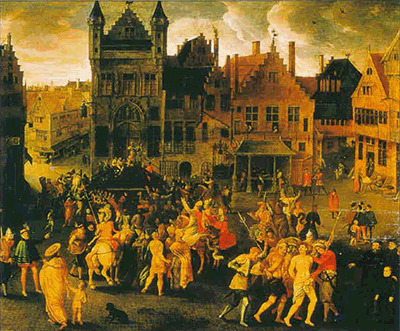
Gillis Mostaert, Passion play in Antwerp; 2nd half of the 16th c.: Christian ‘theater’
There was no theater in Christian times; it was prohibited. And for a very good reason! It was denounced as obscene, vulgar, salacious and disastrous for the moral standards of a Christian society. The only sort of theater that existed in Christian societies was the representation of the Passion of Jesus. Similarly, the sole type of theater that existed in some Muslim societies was the representation of Hussein’s martyrdom in Kerbala; these theatrical acts are performed in independent buildings known as Hussainiya. About:
https://en.wikipedia.org/wiki/Hussainiya
https://en.wikipedia.org/wiki/Ta%27zieh
https://en.wikipedia.org/wiki/Mourning_of_Muharram
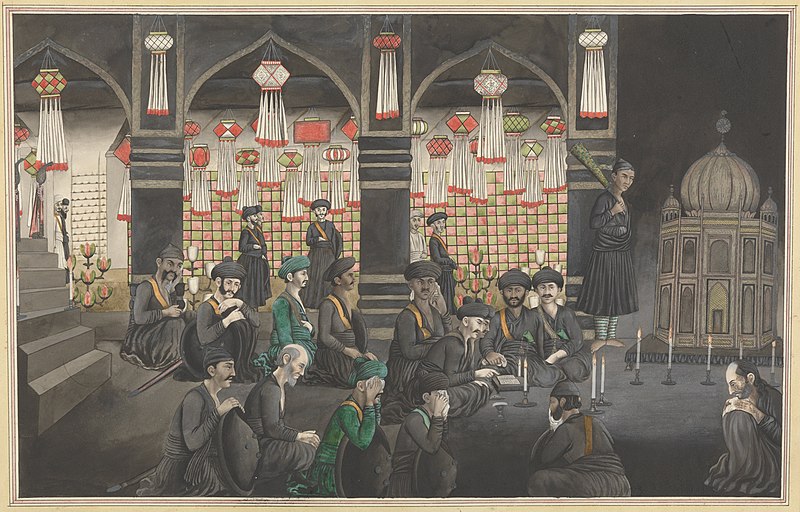
Islamic ‘theater’ (ta’zieh/تعزیه): painting from Lukhnow, Mughal India (ca. 1800)
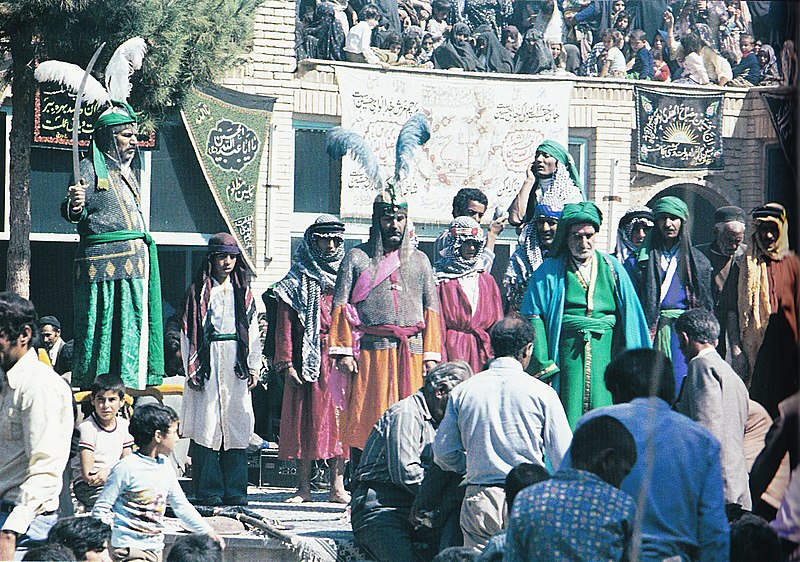
Public representation of Hussein’s martyrdom in Kerbala (680 CE) in Shiraz, Iran (1977)
Theater did not exist in monotheistic cultures and societies, like Assyria and Iran.
Historically, Theater started in Egypt. It was a religious, eschatological theater that involved the representation / repetition of acts and stories narrated as a diachronic or supratemporal description of the Creation, the Life and the End of the Universe. Thus, by ‘acting’ / playing the roles of the major driving forces of the spiritual world, the Ancient Egyptian Iwnw Heliopolitan sacerdotal colleges believed that they truly contributed to the auspicious developments that they expected to take place at the End of Times. In a way, it was a sort of magic, and they considered as such the inner enforcement of external facts and actions (also known as the royal art of Making). Since it was entirely benevolent, they considered it as moral, because it would contribute to the re-establishment of a perfect (or paradisiacal) order that had been lost.
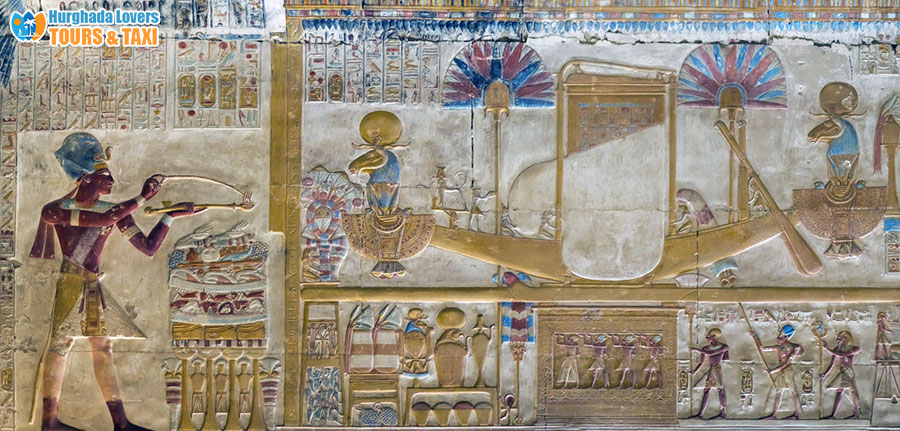
Ancient Egyptian Opet religious festival procession: representation available on bas reliefs
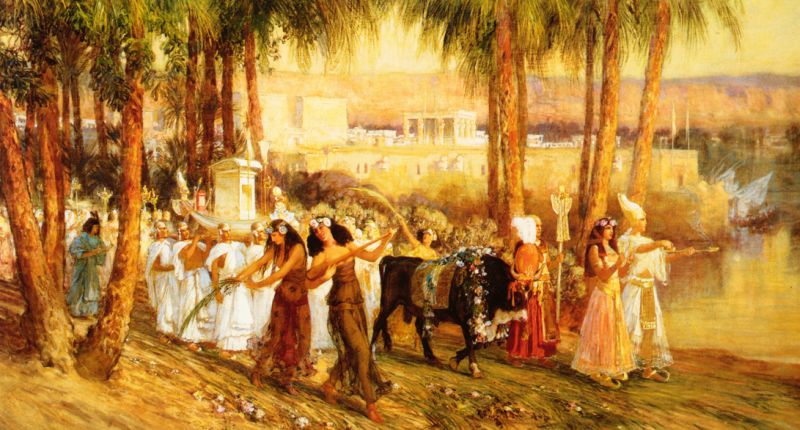
Widely diffused across the Roman Empire, the Ancient Egyptian religious festival Navigium Isidis, as envisioned in 1902 by the American painter Frederick Arthur Bridgman
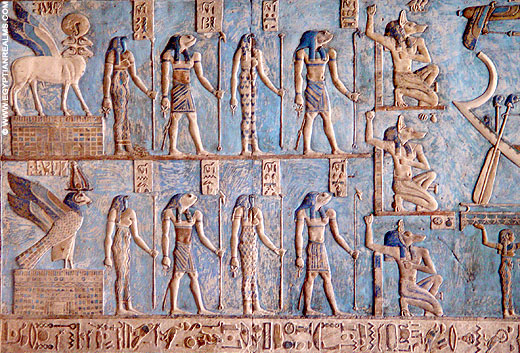
Bas-reliefs with representation of the main Divine Beings of the Hermupolitan dogma (known in Ancient Greek as Ogdoad); during the religious festivals, there were theatrical acts that represented the qualities and potentialities of each of them to faithful followers who participated.
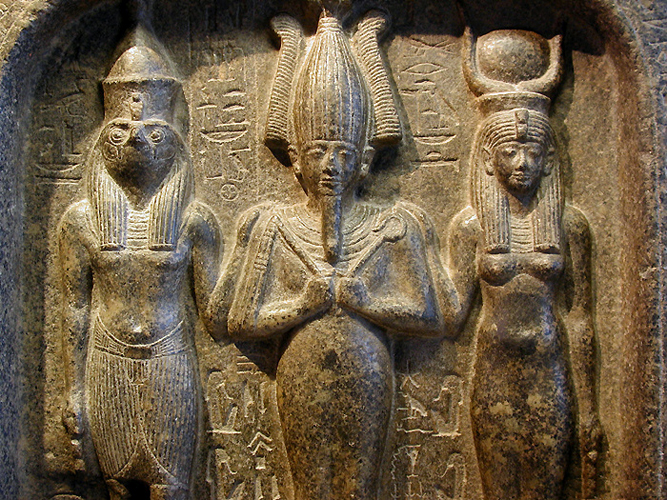
Horus, Osiris & Isis: the major driving forces of the divine world, as comprehended and proclaimed in the Ancient Egyptian Iwnw Heliopolitan religious dogma.
You can correctly assume that Ancient Egyptian, Assyrian-Babylonian, and Hittite eschatology are vast narratives of supreme spiritual endeavors. As such they are at the origin of Ancient Hebrew Biblical (and therefore Christian and Islamic) world conceptualization, worldview, cosmogony, cosmology, eschatology and soteriology. Neither the Messiah nor the Chosen People is an invention of the Ancient Hebrews; as concepts they predate the ancient kingdoms of Israel and Judah by 2000 years, and there is nothing strange in it. The major Ancient Oriental civilizations constitute a hitherto unequaled peak of spirituality, transcendental power, wisdom and spiritual perfection that later nations, like the Phoenicians, the Hebrews, the Iranians, the Greeks and the Romans never reached. But the History of Mankind is a narrative of falls, decay, decadence and corruption, and unfortunately those, who could build great pyramids around the middle of the 3rd millennium BCE, could not do so again 2000 years later.
Meanwhile, the formation of polytheistic religions in Babylonia, Phoenicia, Carthage and elsewhere incorporated early theatrical acts in their religious processions, but this was not anymore a human comprehension of the various aspects of the Divine and of their consequences, but a human invention of otherwise nonexistent stories, which were only useful for the spiritual enslavement of the adepts of each and every religion. In this case, the religion and the early theater turned from benevolent into malevolent, monotheism became polytheism, and moral freedom was transformed into sexual exploitation of the victims (i.e. the believers). Spiritual achievements (like levitation, teleportation, materialization/manifestation, etc.) became ‘miracles’ and the great initiates turned out to become mystical swindlers, petty magicians, and slaves of evil spiritual hierarchies.
In Ancient Greece, theater took progressively a form of moral education, but it reflected the political divisions, the tribal conflicts, and the racist character of their elites, therefore giving deliberately biased and viciously erroneous representation of the ‘Other’, notably the Iranians.
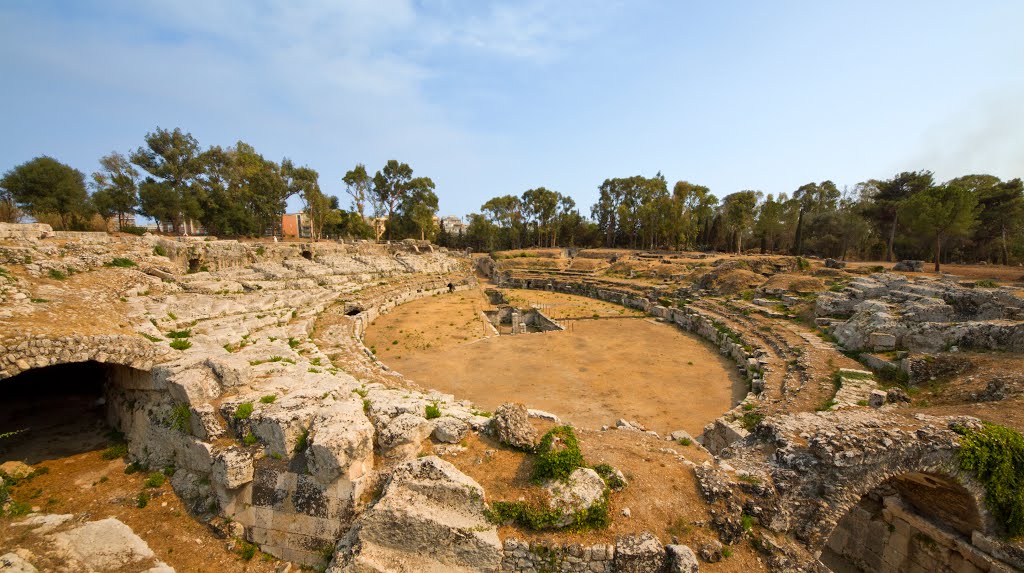
Ancient Roman amphitheater in Siracusa (Syracuse), Sicily
In Ancient Rome, the amphitheaters and the circuses soon superseded to the theater, placing the military training and martial sports at the epicenter of the public interest and entertainment. During the Christian imperial times, the interest for the martial arts continued to generate great enthusiasm, massive attendance, and personal involvement as the illustrious Constantinople Tzykanisterion (Циканистерион) testifies to. (https://wiki5.ru/wiki/Tzykanisterion) Of course, this palatial sport demonstrates a Sassanid Iranian influence on the Eastern Romans. However, it also shows that Constantinople was culturally closer to Turan and Central Asia than to Merovingian France. But the ancient Greek theater was, as I said, entirely forgotten, duly rejected, and wholeheartedly despised as a villainous endeavor and obsolete, anti-Christian activity.

The Tzykanisterion was close to the great palace of Constantinople, by the seaside

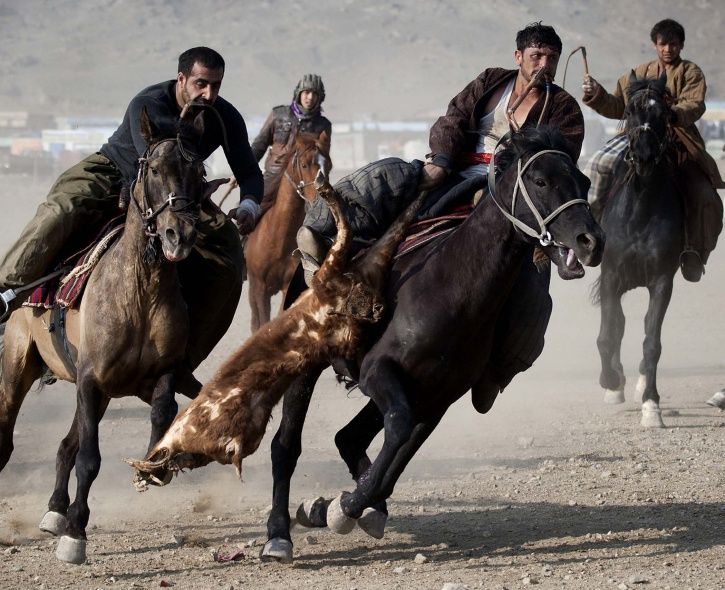
Buzkashi in today’s Afghanistan, Pakistan, Central Asia, China, Iran, Turkey, Russia and Mongolia is similar to the Sassanid Iranian Chowgan which is at the origin of the Eastern Roman Tzykanion. About: https://en.wikipedia.org/wiki/Buzkashi https://en.wikipedia.org/wiki/Chovgan and https://en.wikipedia.org/wiki/Tzykanisterion
After the early diffusion of the racist, colonial and fallacious concepts and ideas of the Renaissance intellectuals and anti-Christian magicians, the rise of Classicism brought forth a return to ancient Greek themes; all the same, the movement was a very wrong imitation of partly or entirely misunderstood topics. However, the end result was a sheer degradation not only in terms of art but also with respect to Moral. This we can fully understand, if we compare the representation of a topic by Ancient Greek playwright and the distortion of the same topic by a Modern European poet. The latter is definitely more immoral, more lascivious, and more sacrilegious. By the way, this entry is very distorted and absolutely false: https://en.wikipedia.org/wiki/Classicism
Example:
Phaedra, as narrated by Euripides in Hippolytus and by Seneca the Younger in Phaedra, and
Phèdre, as represented by Racine, who was born in France a quarter century after Shakespeare came to life in England.
https://en.wikipedia.org/wiki/Phaedra_(mythology)
https://en.wikipedia.org/wiki/Phaedra_(Seneca)
https://en.wikipedia.org/wiki/Ph%C3%A8dre
———————————————————–
Morality, Theater and content degradation: Phaedra from Ancient Greece & Rome to French Classicist Theater to Hollywood Cinema

Phaedra in fresco from Pompeii, ca. 60–20 BCE
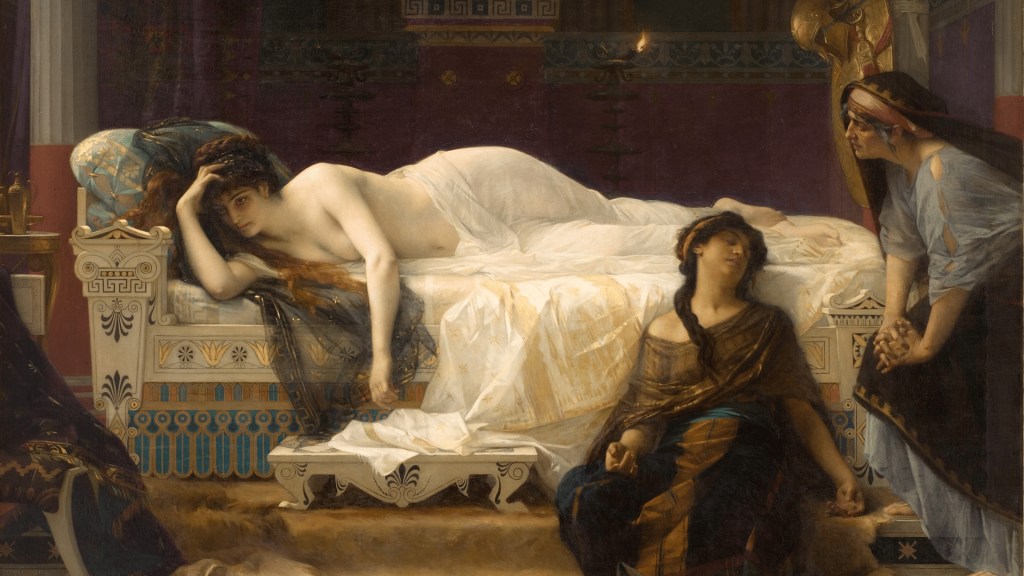
Phèdre; painting (1880) by Alexandre Cabanel (1823-1889): based on Racine’s play
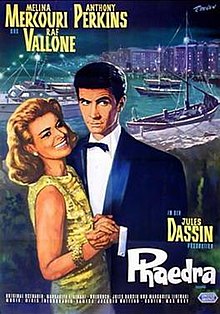
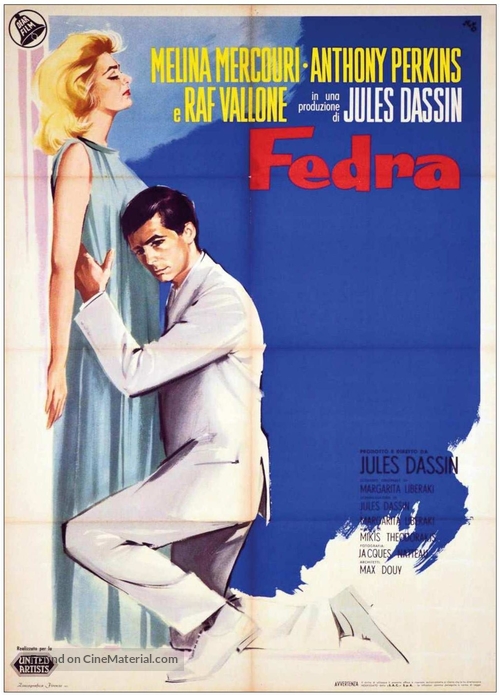
Jules Dassin’s Phaedra, 1962: a disgrace of ‘art’ produced to merely glorify the immoral elite
———————————————————–
As you understand, the issue is far wider than just one author, notably Shakespeare. It has to do with the entire modern Western European literature, art, philosophy, and intellectual-political life, which set the true foundations of today’s decayed, corrupt and infamous Western world. You will perhaps tell me that the Bolshoi Theater, like many other historical theaters built in Russia during the late 18th, the 19th, and the early 20th c., is part of the Imperial, Soviet and Republican social life of the Russians. You are right; but you surely know that the Western European Theater was not part of the Russian popular culture before the early 18th c.
Introducing the modern Western theater in Russia was a key tool of Westernization. But westernizing the non-western is tantamount to subduing, altering and controlling the de facto opponents of the cruel, racist, colonial, modern Western world.
Art played an important role in this regard; many nations worldwide were corrupted not because of the Western theater but thanks to the Western cinema. But this ‘art’, i.e. the fake art of the modern Western world, is detached from Moral, Religion, Culture and Spirituality.
But in reality, there was never a civilization in which Art was uncoupled from the moral considerations, values and principles of a specific nation. In the disreputable, heinous, racist and atheist state of Ancient Athens, which was duly destroyed by the Spartans after three decades of war, the priests denounced as heresy and blasphemy the fact that the worthless sculptor and painter Phidias dared to write his stupid name on his filthy works. There is no artistic value in an impious and sacrilegious work; such shameful works must be destroyed and pulverized.
As you see, I needed an introduction before proceeding to respond to your comments about my suggestion for removal of the English playwright from the Russian (and other) educational manuals. Now, I will focus on this poet.
Of course, you certainly have an idea about the extraordinary eulogies and the unmatched hyperboles that all the English constantly use when they refer to Shakespeare; examined without exaggerations and biases, his art hinges more on his particularity and bears witness to the mystical contents of most of his works. His plays do not allow us to openly describe him as paragon of the Western European Classicism, as it happens with Racine and his opuses. However, Shakespeare used Ancient Greek and Roman stories, myths, concepts and plots extensively.
Consequently, modern English scholars’ effort to dissociate Shakespeare from Modern European Classicism is absurd. Titus Andronicus, Julius Caesar, Troilus and Cressida, Antony and Cleopatra, Coriolanus, Timon of Athens, Pericles Prince of Tyre, and Cymbeline, namely 8 (out of a total of 38) plays have -even in their title- a direct reference to Greco-Roman Antiquity. This makes of Shakespeare a major champion of Modern European Classicism and a very particular playwright indeed among the other Classicists.
VII. Shakespeare’s black magic trickery against the concept of Messiah, and his vicious hatred of Eschatology and Revelation
When it comes to the needs of today’s Russian Education and to the desires of all Russians to see their fatherland as a major pillar in a multipolar world free of Anglo-Saxon perfidy, madness and criminality, I have to state the following points:
First, Modern European Classicism has nothing to do with the Asiatic civilizations that shaped the ancient cultures, which flourished on today’s Russian soil from Scythians to Huns to Tatars; it is therefore improper for Russian schoolchildren to learn what is not theirs and not to study what is theirs.
Second, Shakespeare does not represent anything related to the culture, the past, the civilization, and the spiritual-intellectual heritage of the Asiatic nations that are adjacent to the Russian Federation, namely the Turks, the Armenians, the Georgians, the Iranians, the Kazakhs, the Turkmen, the Azeris, the Uzbeks, the Kyrgyz, the Tajik, the South Asiatic nations of India, Pakistan and Bangladesh, the Chinese, the Mongols, the Tibetans, the Uighurs, and the Koreans. We have therefore to conclude that masterpieces of the literatures of the nations are far more useful for the new Russian generation that will speak Chinese as first foreign language.
Third, there is not a shred of Christian moral in Shakespeare plays; his theatrical plays disastrously encompass unprecedented cynicism, unsurpassed narcissism, absurd arrogance, villainous scheming, abject immorality, loathsome concepts, and plenty of other very negative traits and behavioral notions that are totally unrelated to the core of the Russian soul. Quite often, Shakespeare exacerbates the negative feelings and propels evil characters to the epicenter of the plot; even worse, he does not castigate the evil-minded characters, therefore leaving the audience with the impression that no substantive punishment awaits us at the end.
Fourth, there is not a single element of Russian (or Chinese or Indian or Turanian or Iranian or African or Latin American) value, character or virtue in Shakespeare’s plays. More specifically, and with respect to Russian culture, there are no Ivan Durak, no Baba Yaga, and no three Bogatirs in Shakespeare. And more importantly, there is no Stepan Razin in English history and culture. Quite critically, at the geographical level (whi so much affects and determines Human History), there is no Volga in England. To fully complete, one needs to spell the truth out: there is no heroism in Shakespeare and there are no heroes among the English.
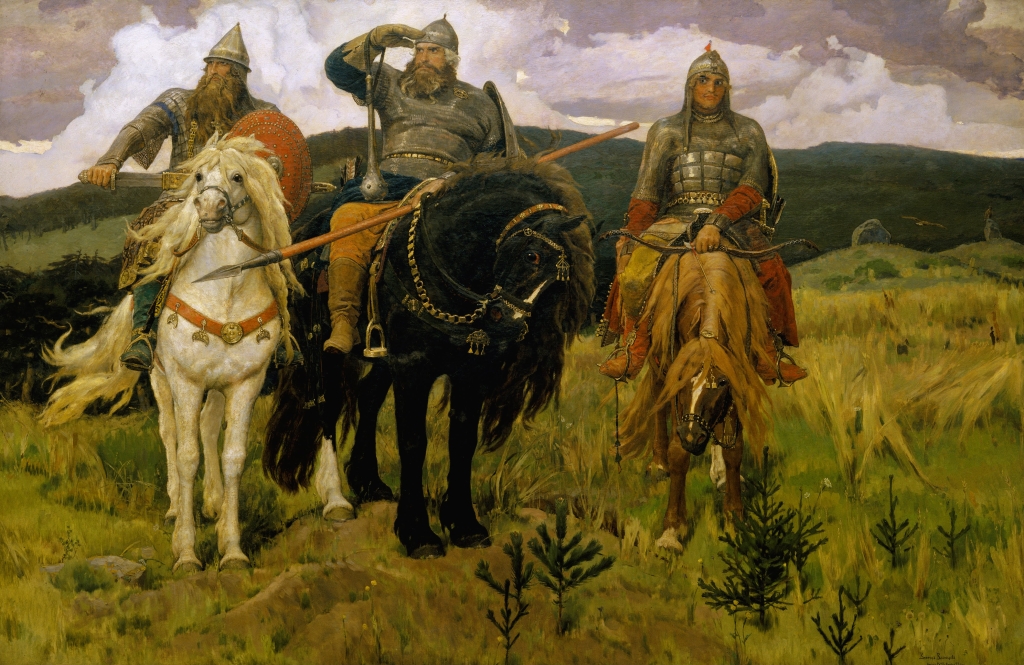
Dobrynya Nikitich, Ilya Muromets, and Alyosha Popovich, i.e. the three Bogatirs after Victor Vasnetsov (1898)
Fifth, in many of his plays, Shakespeare incorporates eschatological and messianic stories and plots, but he does it in a most counterfeit manner. Through his mystical affiliation with the early Freemasons and other secret societies, Shakespeare had been ostensibly initiated in corrupted forms of the Ancient Egyptian Isiac mysteries. Isis- and Horus-related cults flooded, as you know, the Roman Empire in the first 3-4 centuries of the Christian era. Many Isea (Iseum is a temple dedicated to Isis) were excavated and monuments found in Europe, England included. The Egyptian esoteric tradition survived in England clandestinely forming at the antipodes of the Christianization a sub-culture that went down to the Knights Templar and later mystical orders; however, the tradition was progressively corrupted and spiritually dead.
Click to access rob_25_0_139.pdf
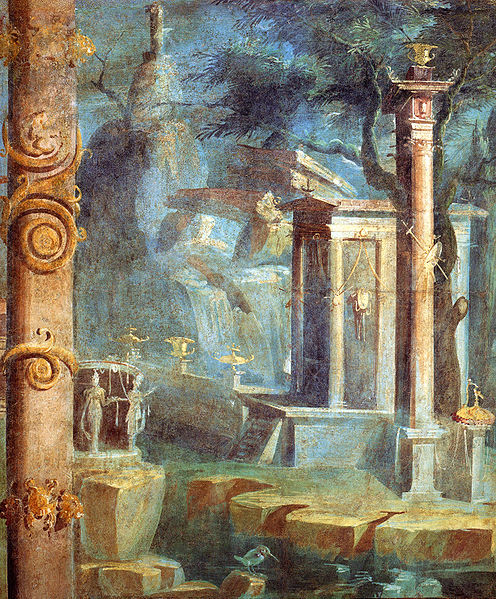
Representation of an Iseum on a Roman fresco from the temple of Isis in Pompeii

Osiris, Horus and Isis: drawing from bas relief, made by the authors of the book ‘Egypt, Handbook for Traveling’ that was published (1898) by the German Verlag Karl Baedeker, the world’s pioneer in travel books. The prestigious edition comprises also 20 maps, 55 plans and 66 views and vignettes. https://en.wikipedia.org/wiki/Baedeker
The original initiates of Isis’ esoteric orders and the faithful, who adored the goddess in Isis’ temples throughout the Roman Empire, believed the Iwnw Heliopolitan dogma that was also known as Ennead among Ancient Greeks during the Late Antiquity. This comprehensive spiritual system of Egyptian cosmogony-cosmology-eschatology/soteriology was extensively popularized in Greek and Latin thanks to the numerous Isis Aretalogies (Ареталогия). Plutarch expanded on the topic in his De Iside et Ossiride (About Isis and Osiris/ Об Исиде и Осирисе), which is part of the voluminous opus Moralia (Ethics). About:
http://ancientrome.ru/dictio/article.htm?a=168647901
https://en.wikipedia.org/wiki/Aretalogy
https://en.wikipedia.org/wiki/Osiris_myth
https://en.wikipedia.org/wiki/Moralia
https://ru.wikipedia.org/wiki/Моралии_(Плутарх)
A Russian translation of the text you can have here: http://www.egyptology.ru/antiq/DeIside.pdf
In several of his plays, Shakespeare ostensibly rewrites the Isis-Osiris-Horus myth. This becomes strikingly clear in Hamlet. In an article of mine published before 30 years under the title “What a priesthood is and how it functions” (Trito Mati, Athens-Greece, September 1993), I established the correct parallels among
a. the original Ancient Egyptian myth,
b. the Revelation by John, and
c. Shakespeare’s Hamlet.
You can find the article (scanned pages of the review) online here (3rd page from the end, in 4 columns):
The correspondence of the major elements of the Ancient Egyptian myth to the main characters of Shakespeare’s play is a vast topic that would need a book to analyze. I herewith provide you with a brief diagram.
| Egyptian Myth | Revelation by John | Shakespeare’s Hamlet |
| Osiris | God | The assassinated King Hamlet, Hamlet’s father |
| Isis | woman clothed with the sun, and the moon under her feet, and upon her head a crown of twelve stars | Gertrud, the Queen |
| Seth | Satan/Dragon | Claudius, the fratricidal king (of this world) |
| Seth (ditto) | {not mentioned} | Polonius, chief priestly figure and father of Ophelia |
| Nephthys | {woman sitting on a red beast} | Ophelia |
| Horus | King of Kings | Hamlet |
| substitute of Seth | beast coming out of the sea/Antichrist | Laertes |
Now, all this is not merely useful for comparative literary analysis and for a dissertation in History of Religions. What matters most in this regard is the way Shakespeare was personally involved in the distortion of the Ancient Egyptian narrative, the Isiac myth, and the eschatological/messianic plot. And this is the most obscure and the most vicious part of Shakespeare’s role and work.

Egyptian Isis as the Christian Revelation’s ‘Woman Clothed with the Sun’ / From Apocalypse Picture Book; English, c. 1255-60; Medieval and Renaissance Manuscripts (MRMSS) B1 350 B MS M.0524; the Pierpont Morgan Library, New York – http://ica.themorgan.org/manuscript/page/16/110814
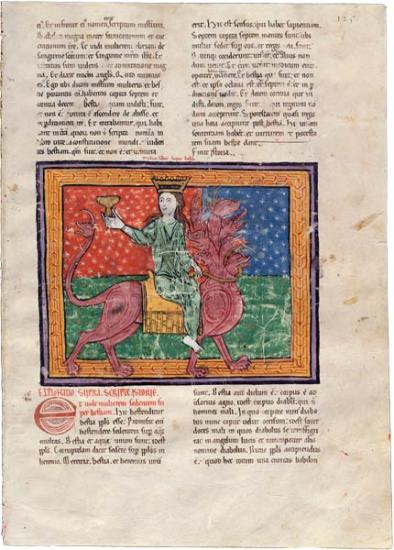
Egyptian Nephthys as the Christian Revelation’s ‘Woman sitting on a red beast’/ From Beatus of Liébana’s Las Huelgas Apocalypse, Spain, ca.1220 (purchased by Pierpont Morgan, 1910); Medieval and Renaissance Manuscripts (MRMSS) B1 363 B MS M.0429; Pierpont Morgan Library – https://www.themorgan.org/collection/Las-Huelgas-Apocalypse/30
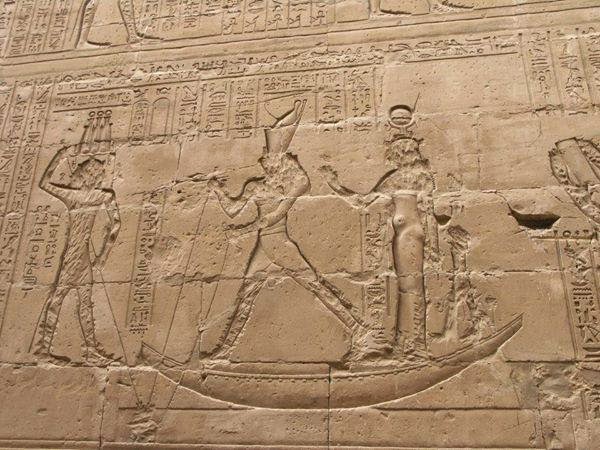
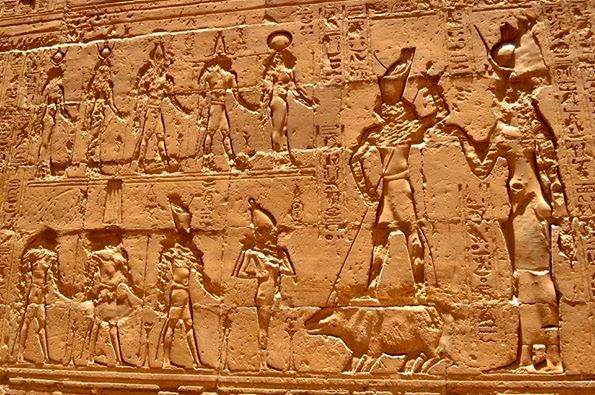
Different moments of the ultimately cosmic, eschatological clash between Horus and Seth (: the Antichrist or Laertes in Shakespeare’s Hamlet), as depicted on numerous bas-relief panels of the interior side of the external wall of the Horus Temple at Edfu (Behedet in Ancient Egyptian) in Upper Egypt, 750 km south of Cairo. The Pharaoh Ptolemy X (Alexander I) appears in several bas reliefs as also fighting against Seth, which symbolizes his close cooperation with the Messianic Heliopolitan priesthood and epitomizes the pro-Heliopolitan nature of his deeds. Seth is alternatively represented as hippopotamus or crocodile. About:
https://www.academia.edu/326697/Inschriften_des_ptolem%C3%A4erzeitlichen_Tempels_von_Edfu
https://www.sterntours.de/aegypten-reisen/aegypten-reisefuehrer/edfu
https://egyptunitedtours.com/tour-attractions/edfu-temple/
https://www.re-thinkingthefuture.com/2022/10/28/a8304-temple-of-edfu-egypt/
https://www.planetware.com/edfu/temple-of-horus-egy-asw-temhor.htm
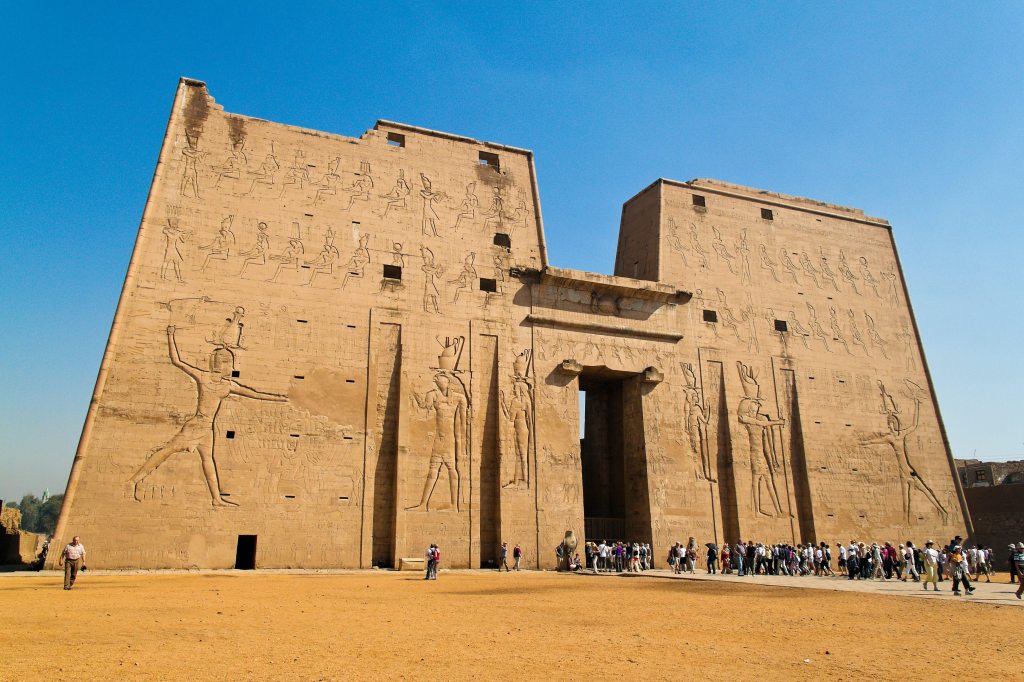
The pylon of the Temple of Horus at Edfu: the most voluminous corpus of texts of the world’s eschatological literature

Entire walls covered with panels of symbolic descriptions detailing, in texts and bas-reliefs, the major episodes of the End Times’ mythical (i.e. absolutely real at the spiritual and the material universes) fight between a. Horus (or Hamlet, Ninurta, Etana, Tasmisu, Messiah, Mahdi, King of Kings, Jesus Christ, Saoshyant, Maitreya, etc.) and b. Seth (or Laertes, Ullikummi, Masih ad-Dajjal, Antichrist/Beast, etc.) Brief presentation – interpretation of Horus’ eschatological drama & ultimate Victory: Edfu Temple and the Sacred Drama of Horus https://egyptraveluxe.blogspot.com/2014/11/edfu-temple-and-sacred-drama-of-horus.html
Read first the Ancient Egyptian myth (either Ancient Egyptian hieroglyphic texts or Plutarch’s essay)! You get an impressive feeling of an overwhelming supratemporal victory and an enthralling prevalence of Horus-Messiah, who rules the spiritually rearranged and rejuvenated world as Emperor, having totally eliminated the evil (Seth).
Read the Revelation by John! There, you get an even more fascinating description of the victory of the King of Kings and of the annihilation of a) Satan (Dragon), b) the Woman sitting on the red beast, c) the Antichrist (Beast), and d) the Pseudo-Prophet. It is an identical narrative, which is incorporated within the nascent Christianity, although in Jesus’ words we find no reference to the three latter spiritual entities.
Read now Shakespeare’s Hamlet! Although basic parts of the plot and even the critical clash (Hamlet exterminating Claudius) are there, we observe with extreme indignation that, minutes after vanquishing Laertes, Hamlet dies too, when he and the rest hear the news of Fortinbras arriving. This makes the difference; the evil difference, I mean. Fortinbras is an absolutely unnecessary figure or character. He is absolutely useless and utterly nonsensical.
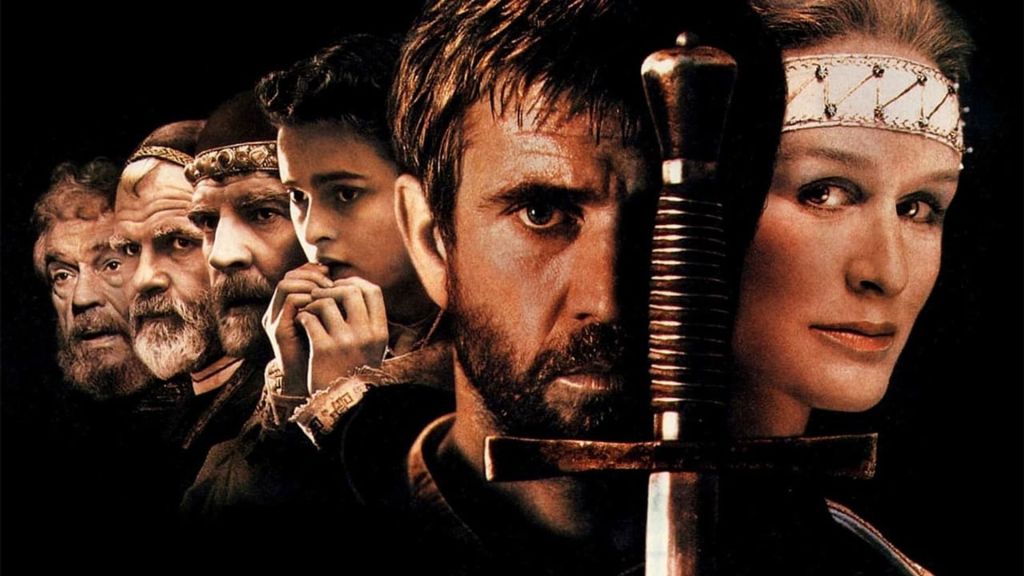
Only because the Satanic nature of Shakespeare wanted the Messiah (or Horus or Jesus-Christ or Mahdi or Etana or Saoshyant or Maitreya) dead and unable to savor his victory, the need for an extra character was created in the plot. It is a devilish trick against the noblest of all prophecies.
Do you know, Fedor, what Fortinbras means?
It means that there will not be any Kingdom of Heaven, because the Messiah/Horus will die at the moment of his victory. This is the World History’s most hateful, most lowly, and more fallacious concept; it constitutes the most blasphemous rejection of the Christian Revelation by John, and of all the anterior and posterior revelations, eschatological epics, and Messianic narratives. It is a vicious and shameless attempt to exterminate Soteriology and a conscious effort to prevent the Ultimate Emperor and Redeemer from ruling the Mankind with iron fist (inferred in Isaiah 11:4; explicitly stated in Psalms 2:7-9; and repeatedly evoked in Revelation 19:15, 12:5, 2:26-28).
Why is this so? Why is Fortinbras so badly needed to Shakespeare’s mystical and devilish peers? This is easy to answer! The evil societies cannot stand every notion of Kingdom of Heaven, because this brings forth their irrevocable annihilation; they therefore passionately and continually intend to disreputably prolong the present situation of the Fallen Mankind as long as they can. Their ‘poets’ perform therefore all possible acts of Black Magic to obtain the desired results. And the premeditated distortion of an eschatological narrative, plot and development, particularly when it is part of a play repeatedly performed by actors and formidably contemplated / cherished by the audience over the centuries (which means an enormous number of victims whose spirituality was held captive), is a very sophisticated form of Black Magic.
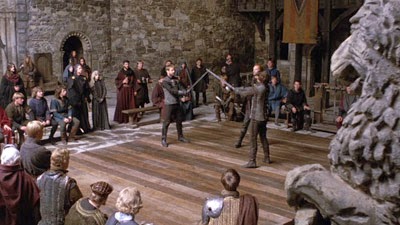
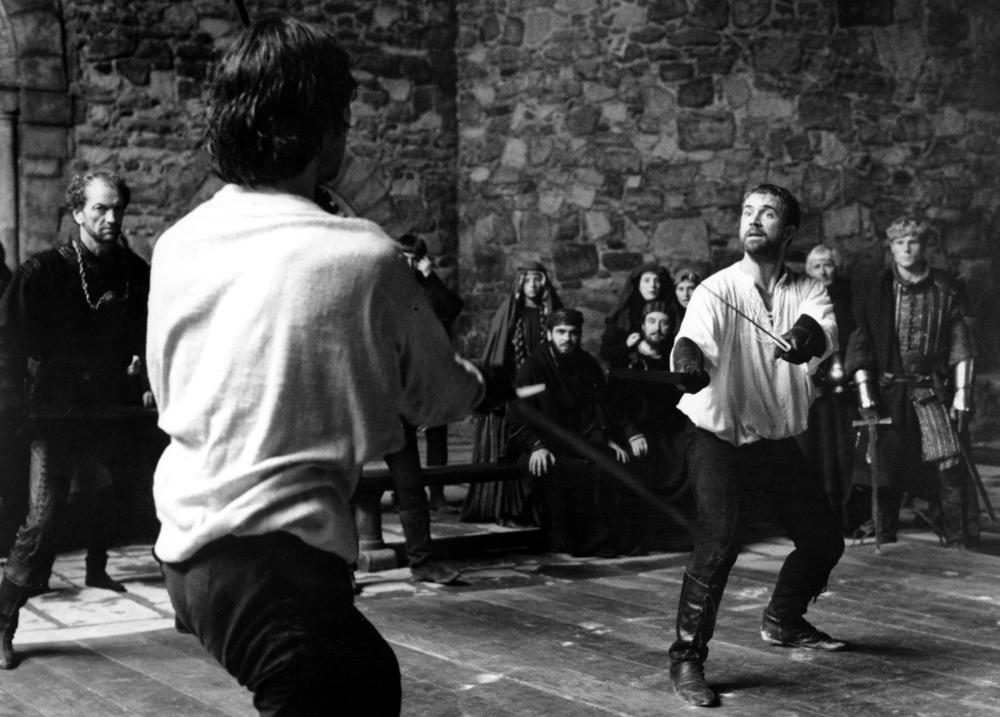
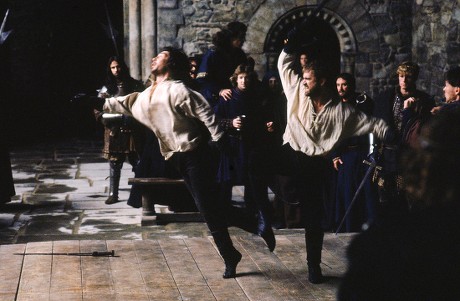

In Shakespeare’s malevolent and black magical eschatology, the Messiah (Horus or Hamlet) wins over the Antichrist (Seth or Laertes), but dies soon after! This irrevocable fact of the World Literature convincingly demonstrates where the location of Evil on Earth is.
Consequently, with a fallen human Fortinbras as bogus-ruler, the present condition will continue, and the (disastrous for Shakespeare and his peers) Kingdom of the Heaven will be delayed or averted.
Shakespeare did not have the strength or the paranoia to make Laertes kill Hamlet. This is genuinely impossible. He therefore did not attack spiritual forces that would madden and annihilate him on the spur of the moment, namely at the time he would be writing such an execrable obscenity. However, his evil nature was good enough to invent the Satanic trick: ‘the Messiah/Horus wins only to die after his victory’. Preposterous!
Exploring Shakespeare’s evil profundity, one can therefore unveil the depth and the extent of the English perfidy. I need now to terminate my lengthy response.
You are very knowledgeable, Fedor! But you seem to forget a critical detail.
Shakespeare was born in 1564 and died in 1616.
His active years are thought to have been between 1585 and 1613.
But the most important event of his life was not the coronation of James VI & I, who was the successor of Elizabeth I.
The historically most determinant fact that took place during Shakespeare’s life was the war between Spain and England (1585-1604) and mainly the circumnavigation of England and Ireland by the Grande y Felicísima Armada (also known as Invincible Armada), i.e. the Enterprise of England undertaken by the Imperial Spanish fleet in July-August 1588.
https://es.wikipedia.org/wiki/Armada_Invencible
https://ru.wikipedia.org/wiki/Непобедимая_армада
https://en.wikipedia.org/wiki/Spanish_Armada
If the Spaniards won, you would never know Shakespeare and his black magical texts, which are idiotically staged in numerous countries worldwide only at their own detriment and to the prejudice of billions of readers and spectators.
You don’t need either Shakespeare or English in Russia. No one needs them.
De-Occidentalization is the guarantee for the Russian victory; and as you can guess, the term comprises also the most resolute de-Anglicization.
Replace therefore Shakespeare in the Russian Education syllabus with the Azeri Nizami Ganjavi, the Armenian Movses Khorenatsi, the Georgian Shota Rustaveli, the Iranian Ferdowsi, the Turanian-Indian Amir Khusrau, the Chinese Guo Jujing (郭居敬) and you will discover all the musical undulations of Nikolai Rimsky-Korsakov’s Scheherazade!
Removing Shakespeare from your education and defenestrating England out of the new multipolar world order, you will lose nothing, but you will gain the whole world! And the world will gain peace.
Thank you again for the opportunity you offered me to expand on these topics!
Best regards,
Shamsaddin
———————————————-
Earlier Publications: Titles, Dates, Links & Contents
From the Pandemic to the Special Operations in Russian Ukraine (3 April 2022)
1- A Critical Confrontation between Jesuits and Freemasons
2- The Pandemic and the Jesuit Eschatological Agenda (and how it has advanced throughout the last millennium)
3- The Multiple Dimensions of the Conflict between Russia and Ukraine
4- The Historical Facts
My position about Ukraine, Russia, and the Russian Special Operations in Russian Ukraine – in brief (15 April 2022)
https://megalommatis.livejournal.com/25045.html
https://megalommatis.blogspot.com/2022/04/my-position-about-ukraine-russia-and.html
https://ok.ru/megalommatis/statuses/154562853352280
https://vk.com/megalommatis?w=wall429864789_6737%2Fall
1. Many people did not expect it, but I did
2. The plan to split Russia to 5-10 pieces
3. There is no Ukrainian language or nation
4. The negative impact of History
5. If Ukrainians are a nation, then Egypt’s Sa’idis are a nation too!
Russia, Ukraine and the World-I: ‘Moscou, les Plaines d’Ukraine, et les Champs-Élysées’ (14 March 2023)
I- The Historical Background
II- Western Colonialism against Russia: Projection of Fake Concepts and Historical Falsehood onto Russian Elites
III- Western Bias: Russia’s Europeanization as De-Russification
IV- Where does the Fallacy of European Russia End?
V- False Identity for Russians means Defeat in the Great Game
VI- The Fall of the Romanov: due to the False Concept of ‘Russia as a European Empire’
Russia, Ukraine and the World-II: 5000 Years of Russian Asiatic Identity vs. 500 Years of Anglo-French Racism & Colonialism (21 March 2023)
I. The Western Anti-Russian Bias
II. Skillful Western European Falsification of Russian History
A. Erroneous contextualization of Archaeology of Northern Asia
B. Deliberate use of overlapping terms: Northern Asia, Siberia, and Scythia
C. Prehistory and Ancient History of Northern Asia are subject to modern borders and to the meaningless attempts for ‘national archaeology’
D. Failure to discern Northern Asia in its entirety and true dimensions
E. Deliberate, multifaceted distortion of the Asiatic Turanian Migrations
F. Minimization of the cataclysmic presence and prevalence of the Turanian nations throughout Eastern Europe
G. European academia-backed biases: malignant disregard of the spiritual value of Kievan Rus, and absurd focus on ethnic, racial and linguistic considerations
H. Erroneous focus on Kievan Rus and disastrous neglect for Volga Bulgaria
I. Concealment of the historical reality of the Turanian (‘Tatar-Mongol’) period
Russia, Ukraine and the World-III: the need for a New UN or how UK, US, France and NATO must be defenestrated from the world (28 March 2023)
https://vk.com/megalommatis?w=wall429864789_8657%2Fall
I. Ukraine or Ireland and Switzerland?
II. England, France, and the fake state ‘US’
III. Ukraine or Mexico?
IV. UK, France, US and NATO: the Enemies of the Mankind
V. The Fallacy of all Geopolitical Analyses
Russia, Ukraine & the World-IV: Continental Empires & Sea Powers – Russians’ Fake Friends & Only Enemy (4 April 2023)
Or how the Romanov collapsed only to the benefit of Serbs’ and Greeks’ Evil Elites
https://vk.com/megalommatis?w=wall429864789_8683%2Fall
https://megalommatis.blogspot.com/2023/04/russia-ukraine-world-iv-continental.html
I. Prof. Huntington’s entirely misunderstood Book
II. The Serbian Delusion of Russians
III. The Clash of Civilization? A Mirage come True
IV. Spirituality & Universalism: Divine Earth vs. Unholy Sea
V. Civilized Continental Empires vs. Barbarian Sea Powers
VI. Continental Empires, Sea Powers, and Divisive Traps
VII. The ‘Greek Orthodox’ Delusion of Russians
Russia, Ukraine and the World-V: the Educational Dimension of the Conflict as the Major Oversight of the Russians (11 April 2023)
https://vk.com/megalommatis?w=wall429864789_8728%2Fall
I. The Political Sodomism of the Western World
II. The Educational Dimension of the Conflict as the Major Oversight of the Russians
———————————————————————————————-
Download the article in PDF:
Download the article with 78 pictures and legends in PDF:
